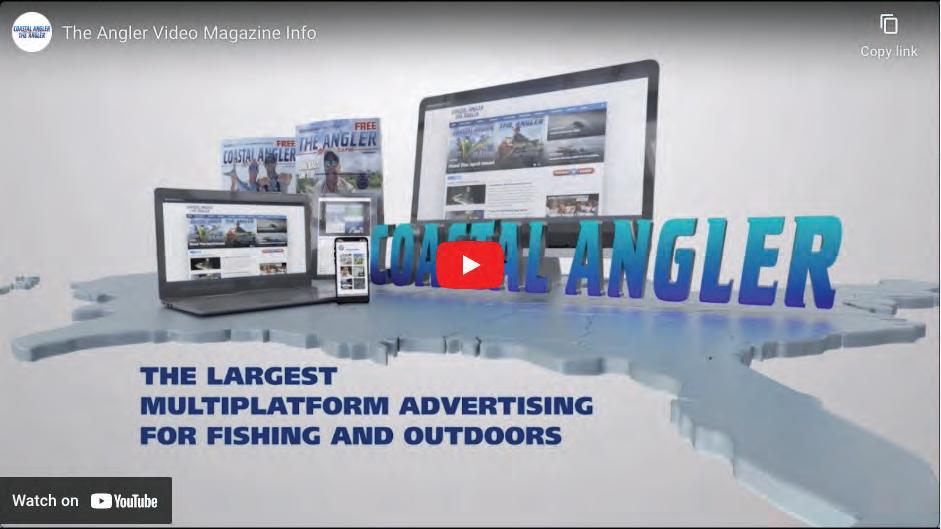


















In 1965 Suzuki Marine launched its first outboard motor, a one cylinder, two-stroke portable known as the D55, generating 4.0kW (or approximately 5.5 horsepower). While this first Suzuki outboard was relatively small and basic, its significance to the recreational boating industry cannot be overstated.
Fast forward six decades, and today Suzuki Marine is an outboard power pioneer with an all 4-stroke line up ranging from 2.5 to 350 horsepower, each model engineered to provide boaters with the latest technology and deliver superior performance, fuel efficiency and reliability. Over this time, Suzuki Marine has won an unprecedented nine National Marine Manufacturers Association (NMMA) Innovation Awards for motors ranging from 25 horsepower to the company’s current flagship 350 horsepower V6 outboard with twin contra rotating propellers. Eight of these awards have been for 4-stroke outboards, which is the industry’s largest number of NMMA awards in the engine category.
Suzuki Marine is celebrating its 60th Anniversary—and the culmination of all the company has achieved over the years—with its Most Valuable Lineup (MVL) for 2025. Suzuki’s Most Valuable Lineup, showcases clean, stylish and luxurious color palettes and graphics that deliver a clear message — these outboards look as impressive as they perform. This new MVL look will first be seen on the Suzuki’s popular V6 lineup, with models ranging from 200 to 350 horsepower covering a variety of fresh and saltwater vessels. It will soon be expanded to other outboards across the line to create a unifying look.

The look may be what sets it apart, but the meaning of Suzuki’s Most Valuable Lineup runs much deeper. As history shows, Suzuki is the industry leader when it comes to true innovation meant not to capture headlines, but to benefit the greatest number of boaters possible. It’s why Suzuki Marine has won Innovation Awards for all types and sizes of motors — including models as small as 25 horsepower. “Suzuki has always believed in delivering the best technology possible for the widest variety of boats — whether you have a small pontoon, an offshore fishing machine or anything in between,” said Brandon Cerka, Suzuki Marine General Manager Sales & Marketing. “It’s this commitment that makes Suzuki’s full roster of motors the Most Valuable Lineup in boating,” added Cerka. Who knows what the next 60 years will bring? One thing is sure, Suzuki Marine will continue to innovate and break new ground when it comes to giving all boaters the performance, efficiency, and reliability they deserve.
To learn more about Suzuki Marine's Most Valuable Lineup, visit your local authorized Suzuki Marine dealer, call Suzuki Marine USA headquarters at (813) 687-7200 or visit www.suzukimarine.com.






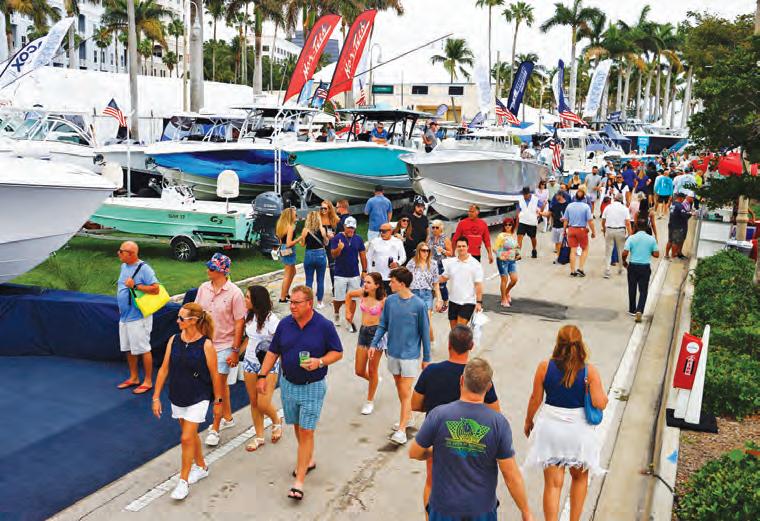

By Ben Martin, Editor in Chief
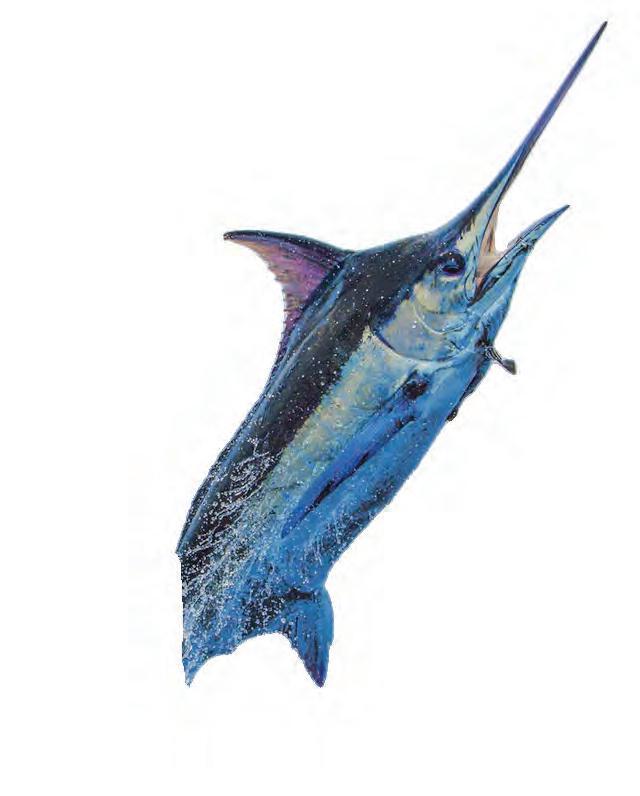

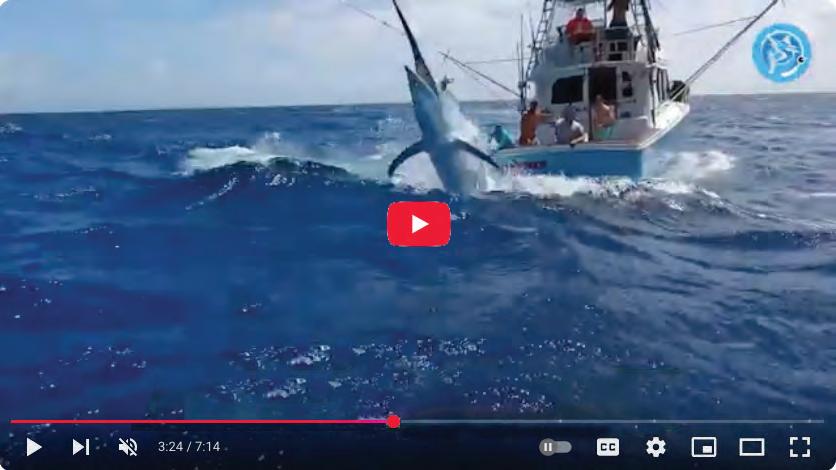

Fishing is a beloved pastime that transcends borders, drawing anglers to new destinations around the globe. Whether it’s the thrill of chasing trophy fish, exploring pristine environments, or immersing oneself in local cultures, traveling to fish offers a unique and enriching experience. But why do so many anglers feel compelled to venture far from their home waters to cast a line? Here are some key reasons behind this phenomenon.
For many anglers, the chance to catch a once-in-a-lifetime fish is a driving force behind their travels. Different regions are home to specific species that can’t be found elsewhere. For example, the tarpon-rich waters of the Florida Keys, the salmon runs in Alaska, or the giant trevally in the Seychelles all serve as magnets for anglers. The challenge of targeting these iconic species and the bragging rights that come with landing them often justify the journey.
Fishing in new destinations allows anglers to experience a variety of ecosystems, each with its unique beauty and challenges. From tranquil mountain streams and sprawling freshwater lakes to turquoise saltwater flats and deep ocean trenches, the diversity of fishing environments is staggering. This variety not only enhances the adventure but also broadens an angler’s understanding of aquatic habitats and their importance to global biodiversity.
Traveling to new fishing destinations often requires anglers to adapt and learn. Different locations come with unique fishing techniques, such as fly fishing in Montana’s rivers, jigging for tuna in offshore waters, or using traditional handlines in tropical locales.

Each trip is an opportunity to acquire new skills, refine existing ones, and deepen one’s appreciation for the art and science of fishing.
Fishing inherently fosters a deep connection with nature, but traveling amplifies this experience. Anglers often find themselves in remote, untouched locations where the tranquility and beauty of the natural world are at their peak. This immersion provides a welcome escape from the stresses of daily life and fosters a sense of mindfulness and gratitude.
Fishing trips often bring people together, whether it’s through shared experiences with friends and family or encounters with local guides and fellow anglers. These interactions
create lasting memories and a sense of camaraderie that extends beyond borders. In turn, the stories and photos from these adventures become cherished mementos, sparking conversations and inspiring others to pursue their own fishing journeys. Coastal Angler Magazine and its digital magazine The Angler Video Magazine have always tried to bring you news and awareness about exotic fishing destinations around the world. Your trips and adventures are an integral part of our monthly compilation process. Your photos, videos and stories about your fishing trips are always welcomed here.
For many anglers, fishing is more than a sport—it’s an adventure. Traveling to


new destinations satisfies the innate human desire to explore the unknown and conquer its challenges. Whether it’s navigating unfamiliar waters, encountering unpredictable weather, or matching wits with elusive fish, each trip is a thrilling chapter in an angler’s personal story.
The reasons anglers travel to fish are as diverse as the destinations they seek. From the pursuit of trophy catches to the joy of exploring new landscapes, each journey offers a blend of excitement, education, and enrichment. For those who fish, the world is not just a playground but a treasure trove of opportunities waiting to be discovered. So, pack your gear, book that trip, and embrace the adventure—the next big catch might be just a plane ride away.
To submit your catch photos, videos or stories, email editorial@ coastalanglermagazine.com.
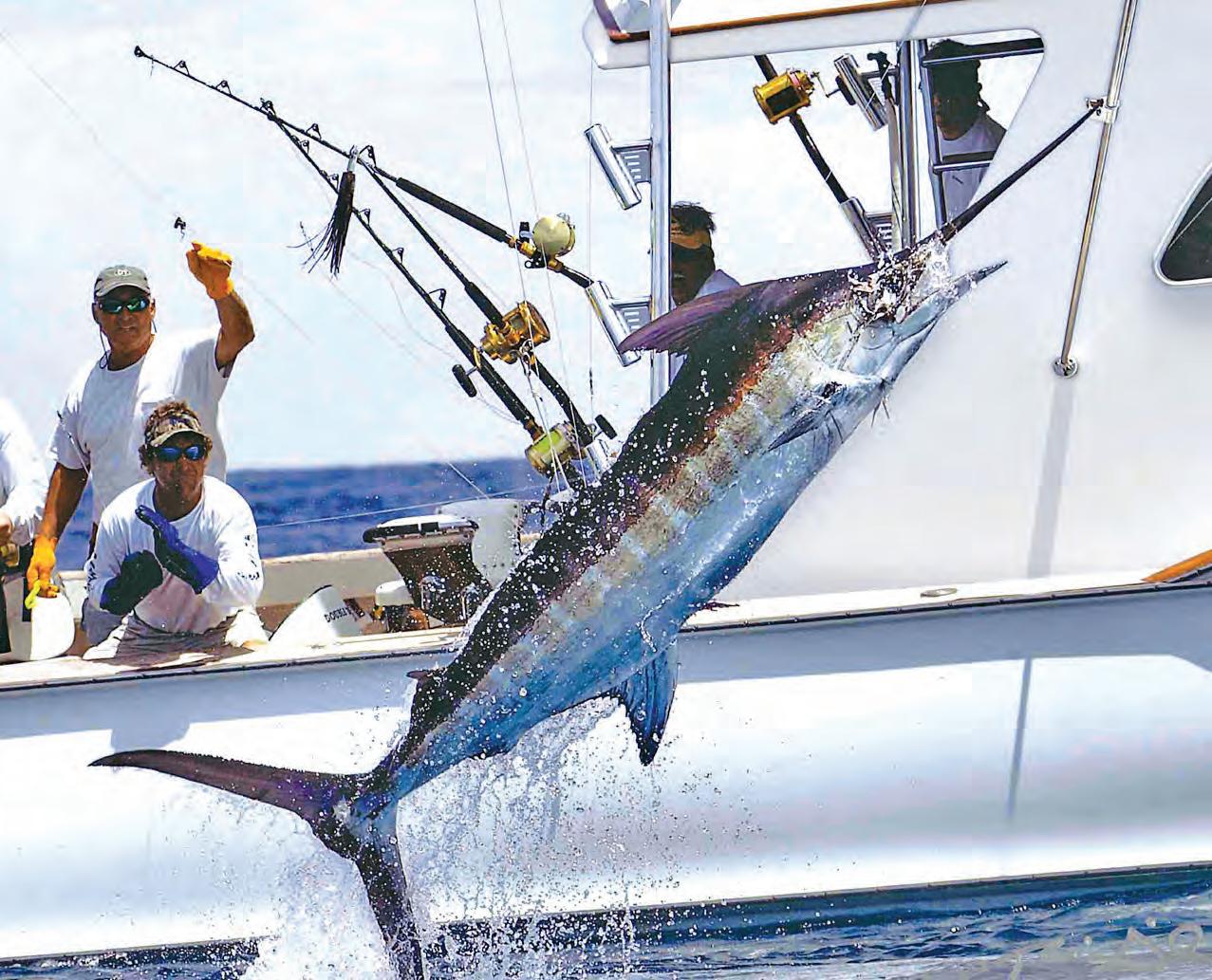

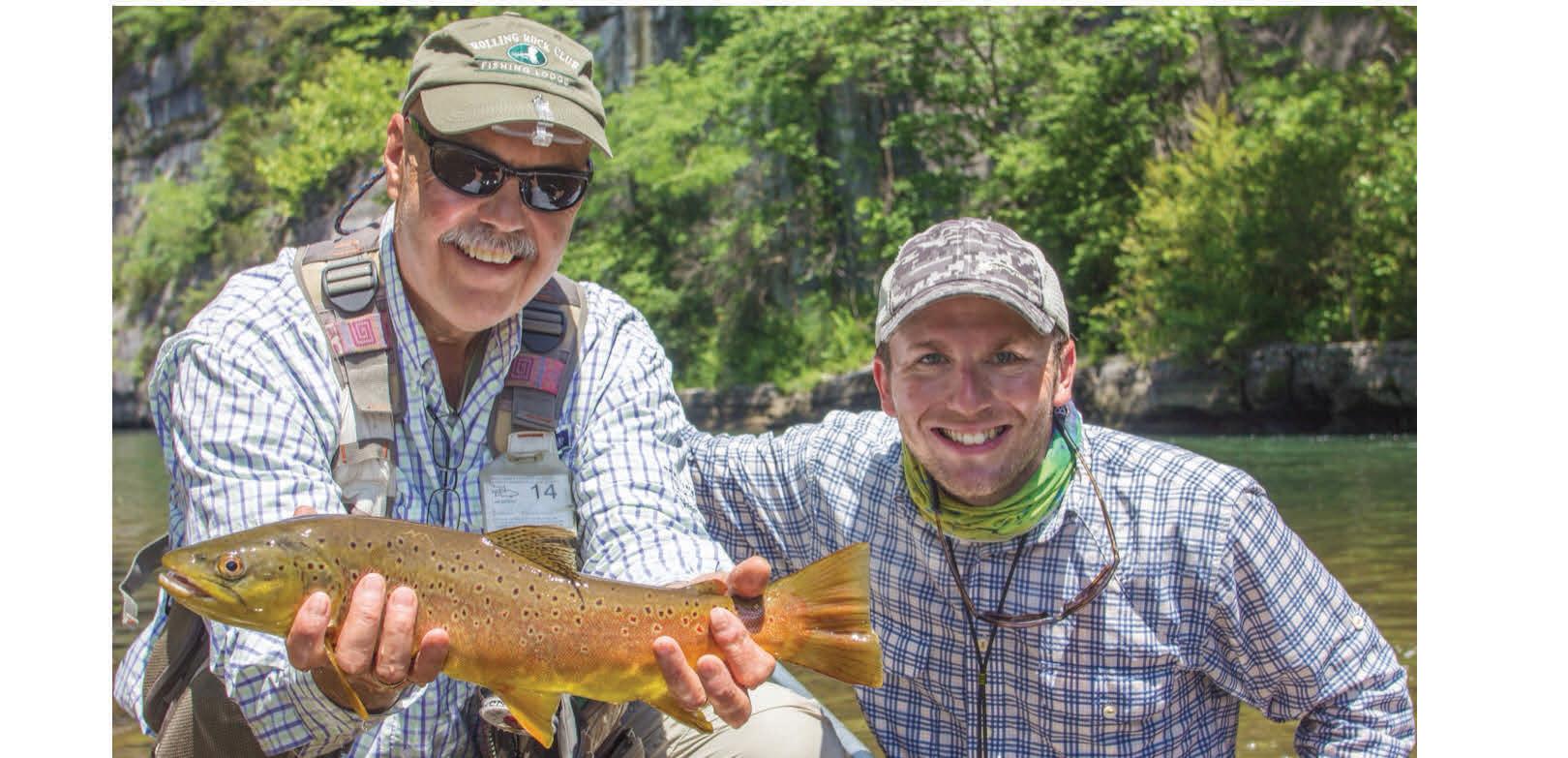









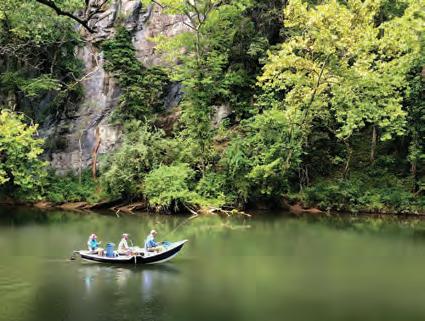















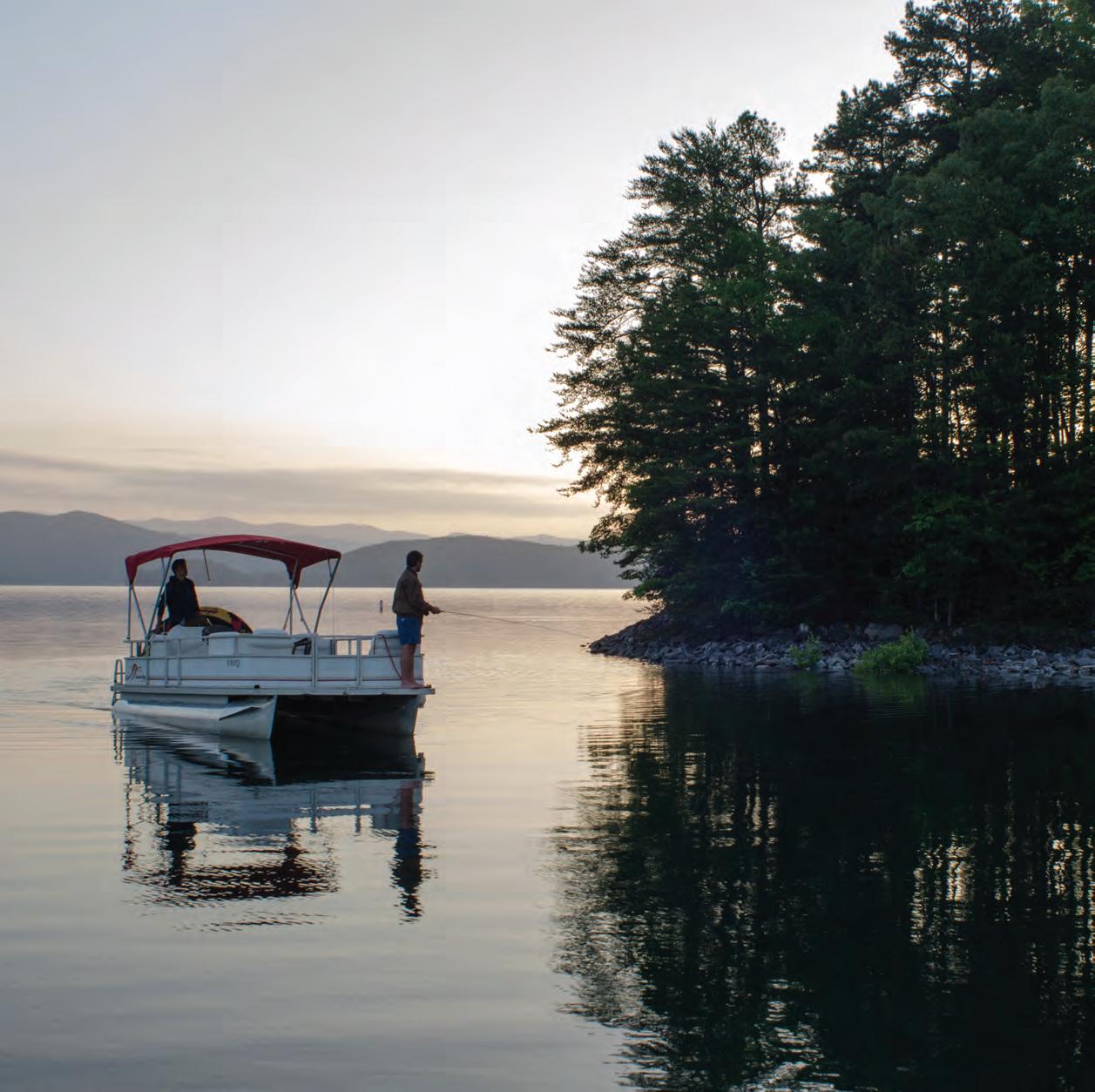
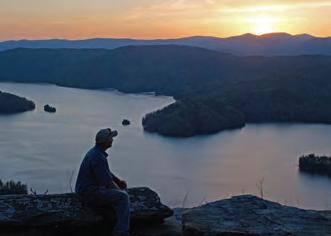


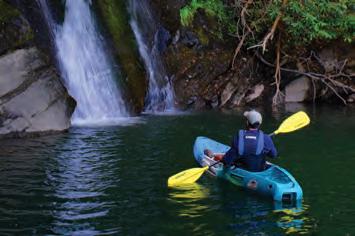


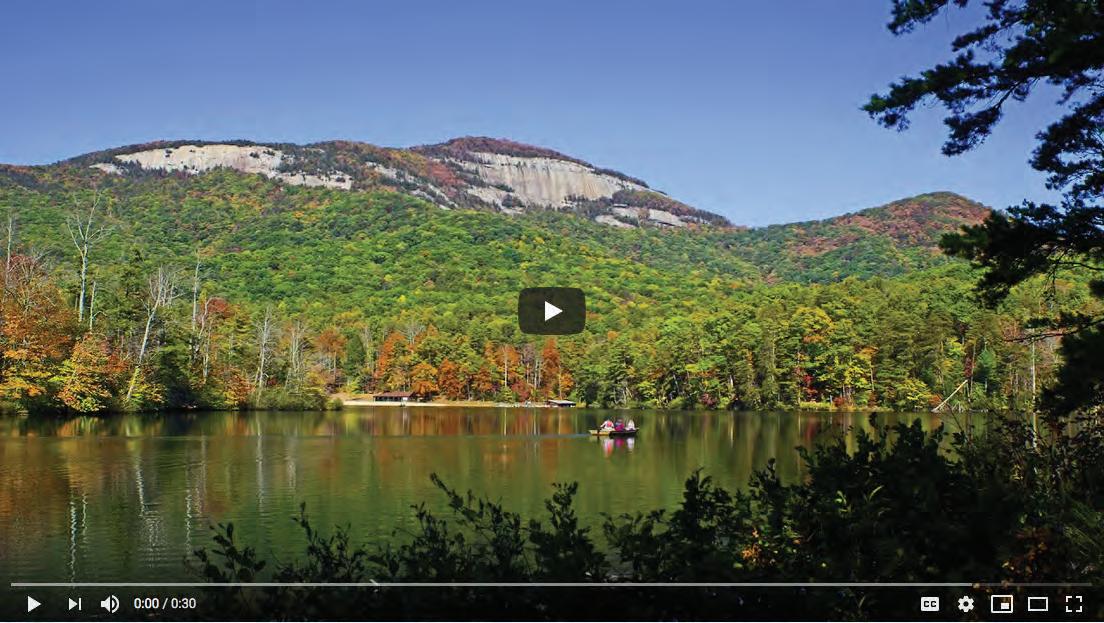


You don’t need an invitation to have fun in Upcountry South Carolina: Come kayak crys-tal blue lakes, hike to rushing waterfalls, dig into local cuisine, attend family oriented events and breathe fresh mountain air. But when you hold a South Carolina fishing license, it feels like an official ticket to enjoy the great outdoors.
Fish bite year-round in the lakes, rivers and streams of Upcountry South Carolina, which is located in the state’s northwest corner in the foothills of the Blue Ridge Mountains. Devils Fork State Park in Salem is a great place to access Lake Jocassee, which holds state records for rainbow trout, brown trout, redeye bass, smallmouth bass, spotted bass and yellow perch. Or try your luck at Lake Hartwell, at Lake Hartwell State Park in Fair Play and Sadlers Creek State Park in Anderson, three-time host of the Bassmaster Classic.
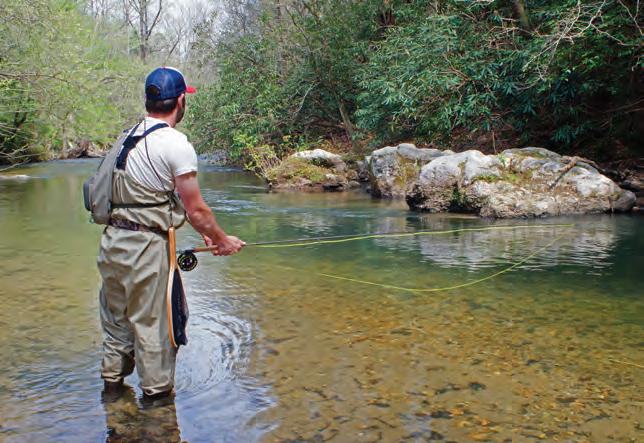

The Chattooga River boasts healthy wild trout populations and is also regularly stocked by Oconee County’s Walhalla State Fish Hatchery. The Whitewater River above Lower White-water Falls is another great option for wild trout. Lake Keowee, at Keowee-Toxaway State Park in Pickens County, swims with largemouth, smallmouth and spotted bass, crappie, bluegill, yel-low perch, catfish, brown and rainbow trout.
Pick up everything you need—including advice— at local fly shops or book a guided fish-ing trip. Sam Jones, of Jocassee Charters, puts anglers on trophy trout. Buster Green’s Guide Ser-vice reels in stripers, hybrids and bass on Hartwell and Keowee. Chattooga
River Fly Shop leads fly fishing trips on the Chattooga and Chauga rivers.
Even if you don’t fish, you can still get on the water. Jocassee Lake Tours offers tours of the lake and of Jocassee Gorges, which National Geographic called a “destination of a Lifetime.” Some amazing spots can only be reached by boat. Several tours are offered, so you can learn from a naturalist while riding on a pontoon or paddle a kayak through coves and under waterfalls.
Prefer to captain your own boat? There are several rental companies, including Tri-County Boat Rental, on Keowee, Jocassee, Hartwell and other lakes.
If you’d rather be under the water, Jocassee is a world-renowned freshwater diving desti-nation that boasts visibility of more than 50 feet at depth. Lake Jocassee Dive Shop offers lessons and guided trips to see “The Wall,” where a section of mountain was blasted to build the dam, or a 40-foot swim-through wooden sailboat.
From fishing to boating, hiking to camping, biking to bird watching and more, the Up-country’s state parks are a great place to play. Dip into the swimming hole at Oconee State Park. Hike to the tops of Pinnacle and Table Rock mountains at Table Rock State Park. Explore the 13,000-acre Mountain Bridge Wilderness Area at Caesars Head State Park. Or create your own adventure at any of the Upcountry’s 13 state parks.
UpcountrySC.com to learn more.

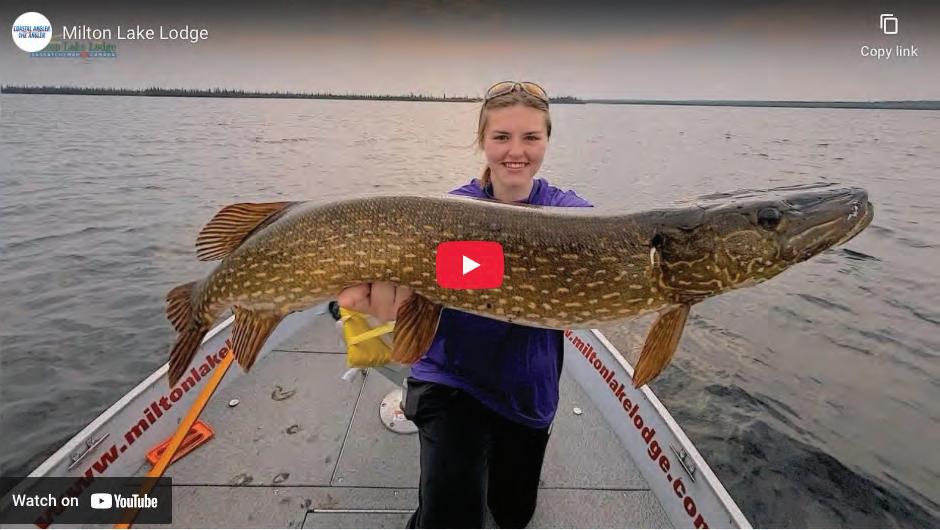

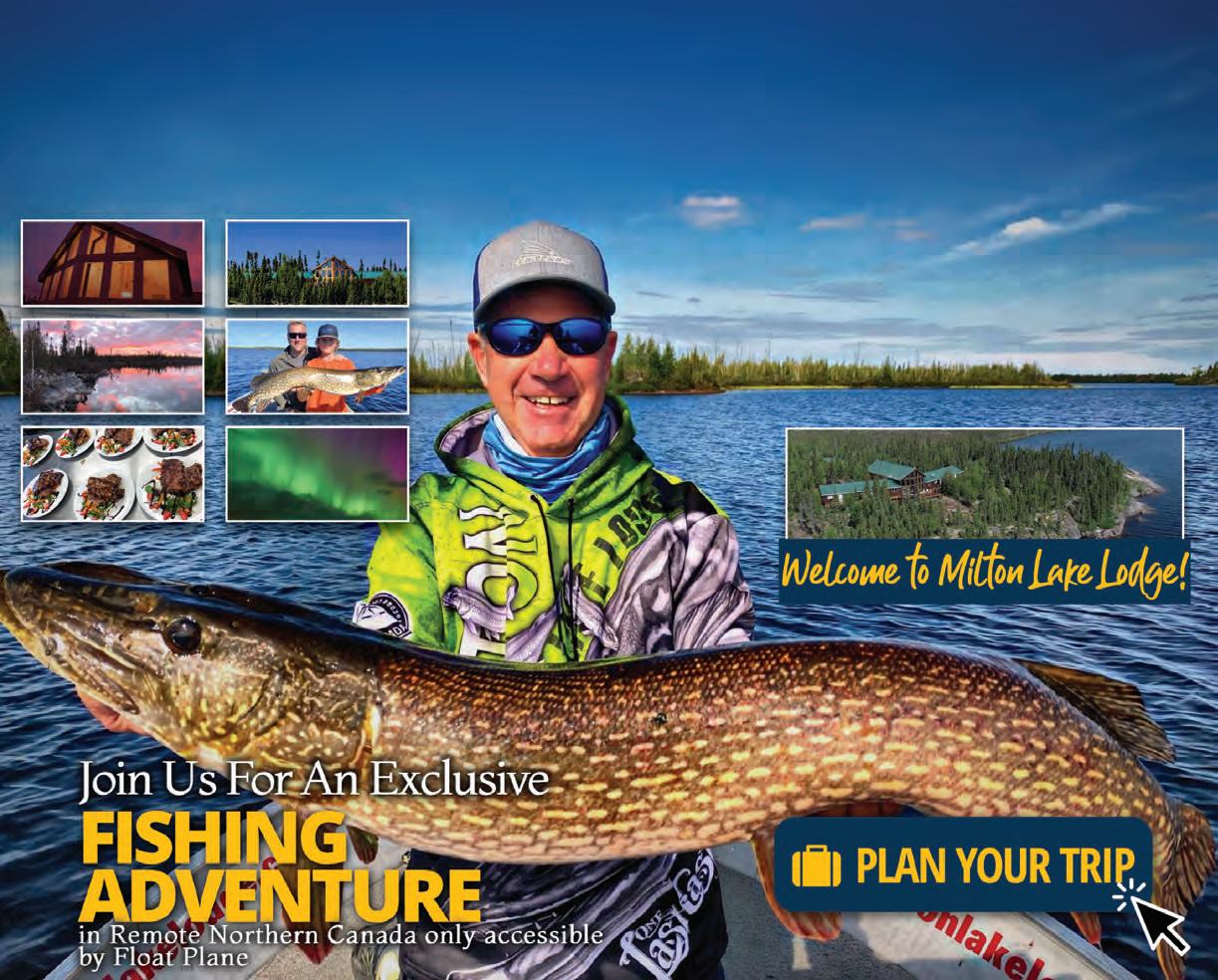

THATCH MAGUIRE, EDITOR AT LARGE
Fishing guides are more than just skilled anglers; they are the heart and soul of the fishing experience for many enthusiasts. Their passion for the sport and the outdoors transforms an ordinary fishing trip into an unforgettable adventure. At the core of their dedication is a love for fishing, a desire to share that passion, and a commitment to teaching and connecting with others.
For fishing guides, their day often begins before sunrise. They meticulously prepare their gear, boats, and bait, ensuring every detail is perfect for their clients. This preparation goes beyond just logistics; it’s a reflection of their devotion to the craft. Each knot tied, hook sharpened, and rod prepped is a testament to their pursuit of excellence. For them, guiding is not just a job—it’s a way of life.
One of the defining traits of fishing guides is their deep connection to nature. They spend countless hours on the water, observing patterns, weather changes, and the habits of fish. This intimate knowledge allows them to read the environment like an open book. They know when and where the fish will bite, and their insights often lead to successful outings for their clients. This expertise is born from years of

dedication and a genuine love for the ecosystems they navigate daily.
But the passion of fishing guides extends beyond their skill and knowledge. It’s evident in the way they interact with their clients. Whether guiding a seasoned angler or a first-timer, fishing guides take pride in creating a personalized experience.
a connection to the sport and the natural world.
The role of a fishing guide is also deeply tied to education. Many guides see themselves as stewards of the water, teaching clients about sustainable fishing practices and the importance of conservation. They share tips on catch-and-release techniques, explain the impact of overfishing, and highlight the significance of protecting habitats. This aspect of their work reflects their commitment to ensuring future generations can enjoy the same bountiful waters.



They celebrate every catch, no matter how small, and share in the joy and excitement of their clients. For them, it’s not just about landing the biggest fish but about fostering
Despite the challenges of the job, including long hours, unpredictable weather, and the pressure to deliver results, fishing guides remain unwavering in their dedication. Their love for fishing and their desire to share it with others fuel their resilience. For many, the reward lies in the moments of connection: a child’s first catch, a client’s excitement at a record-breaking fish, or the quiet satisfaction of a day well spent on the water.
The passion of fishing guides is contagious. It inspires those who fish with them to appreciate not only the thrill of the catch but also the beauty of the environment and the camaraderie the sport fosters. Through their dedication and enthusiasm, fishing guides play a vital role in keeping the tradition of fishing alive and thriving. They are the unsung heroes of the angling world, quietly weaving their love for fishing into the fabric of countless lives.


If you weren’t lucky enough to see the global unveiling of Dometic’s new DG3 Gyro Stabilizer at the 2025 Miami Boat Show, you owe it to yourself to check out this truly innovative system for boats ranging from 35 to 41 feet.
FASTER STABILIZATION - The DG3 spins up and is ready to smooth out the roughest seas in a fraction of the time of competitive systems, so you can get out there and get fishing faster. Dometic’s proprietary technology captures energy and generates its own electric current — cutting overall power consumption by 40%! At the end of your angling adventure, it spools down in 20 minutes — compared to 8 hours or more for other systems.
UNPARALLELED STABILITY - Whether anchored or underway, experience total vessel control with the future seamless integration of DG3 marine gyro with your Dometic steering, trim tabs, and other control surfaces. This advanced system improves dynamic performance, delivering superior roll reduction and ensuring a smoother, more comfortable ride on the water.
REDUCED PASSENGER FATIGUEEnsures a safer and more enjoyable experience.
EFFORTLESS OPERATION AND
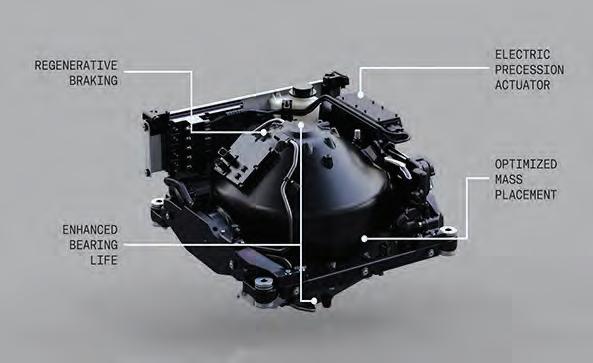
CONFIDENCE – DG3 marine gyro offers seamless digital connectivity with HTML5 and future app integration, compatibility with 12-48VDC inputs, and an intuitive user interface.
ADAPTS TO CHANGING SEAS –Delivers quick, effective stabilization.
Better performance, reduced maintenance, and lower long-term cost of ownership — you’ll find all this and more in Dometic’s new DG3.

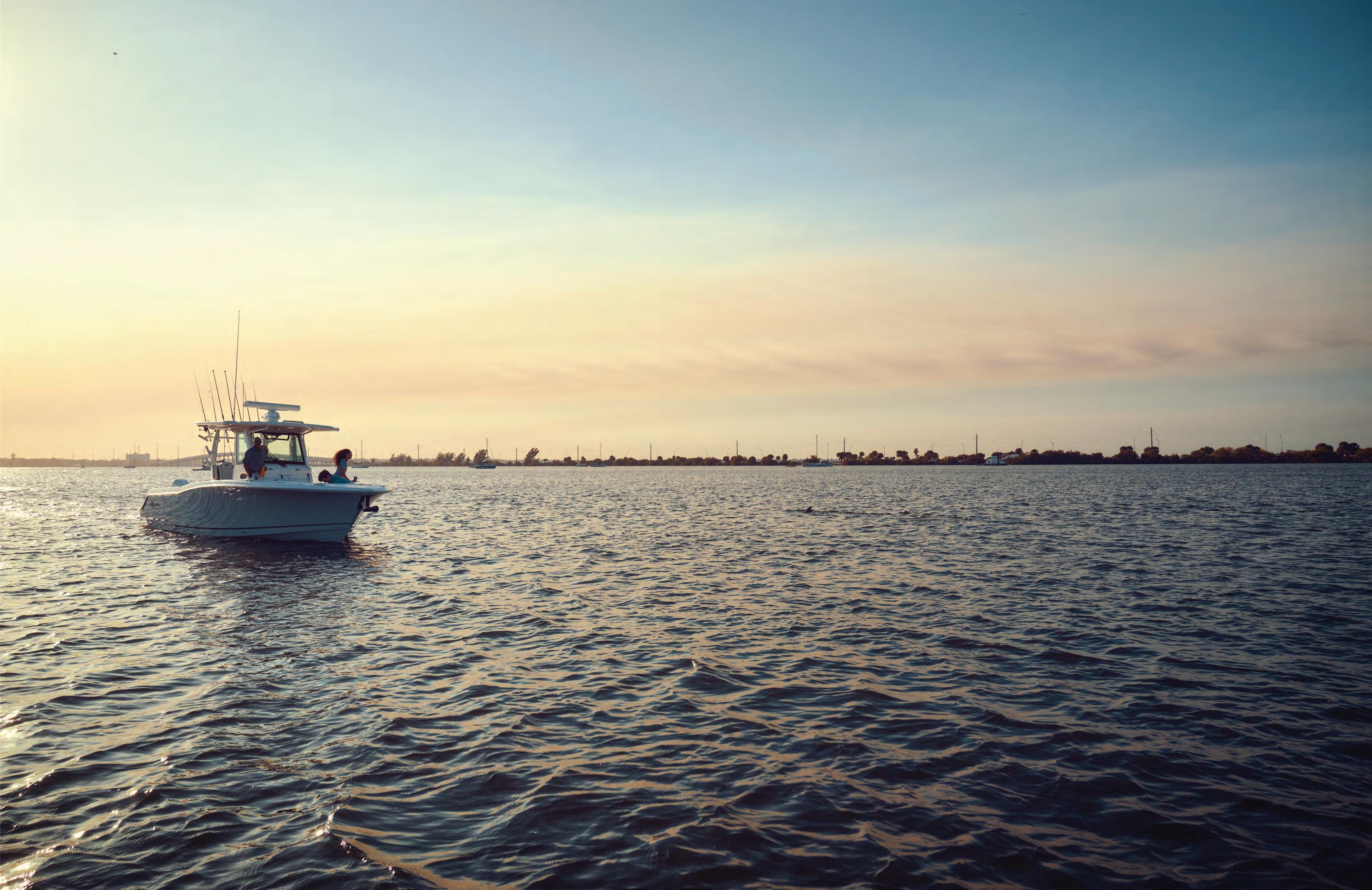
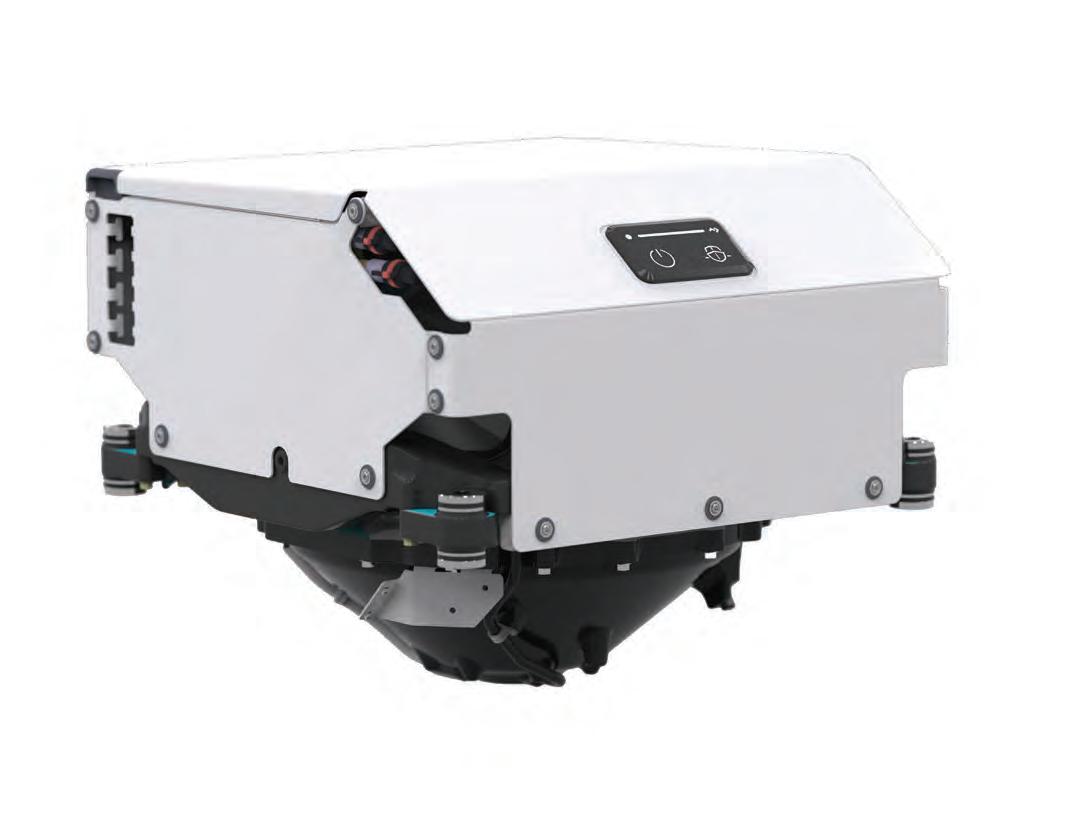


Center console spaciousness meets family-friendly versatility in the Sailfish 232 Center Console. With an array of features and options for fishing trips and fun-filled outings, the 232CC delivers premium quality in an easily towable, effortlessly enjoyable package.
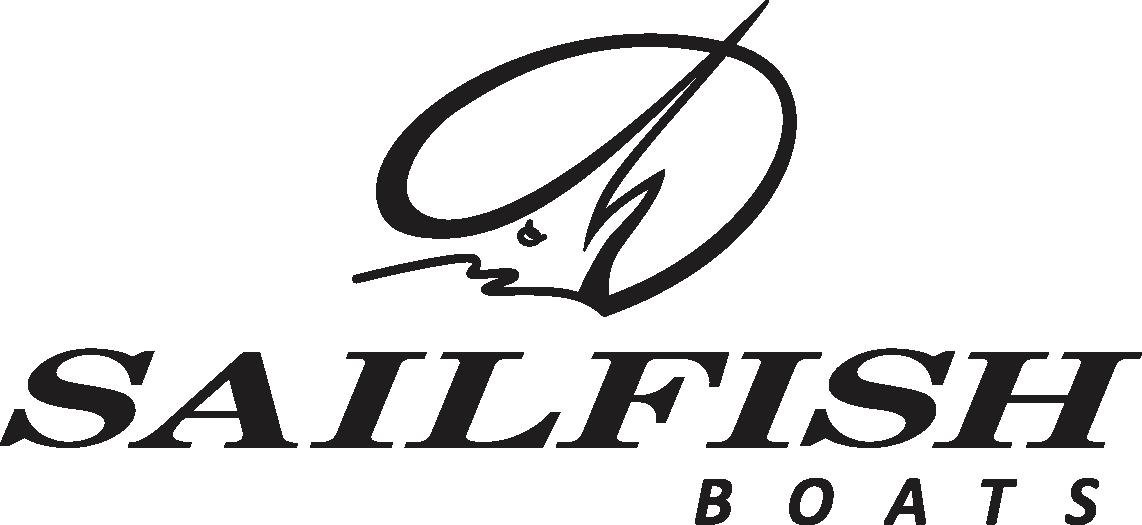
What started as a morning of unproductive wahoo trolling north of St. Augustine turned into an unforgettable battle with one of Florida’s most prized catches. Capt. Daniel Levesque and his crew aboard Rare Breed had spent hours searching for wahoo, battling against an uncooperative west wind, when they decided to switch tactics.
By Brandon Shoaf
worn butterfly jig to about 60 feet.
“It got hit by what felt like a train,” Lorenz describes. “The conventional reel was screaming. At first, I thought I had a shark, but it felt different.”
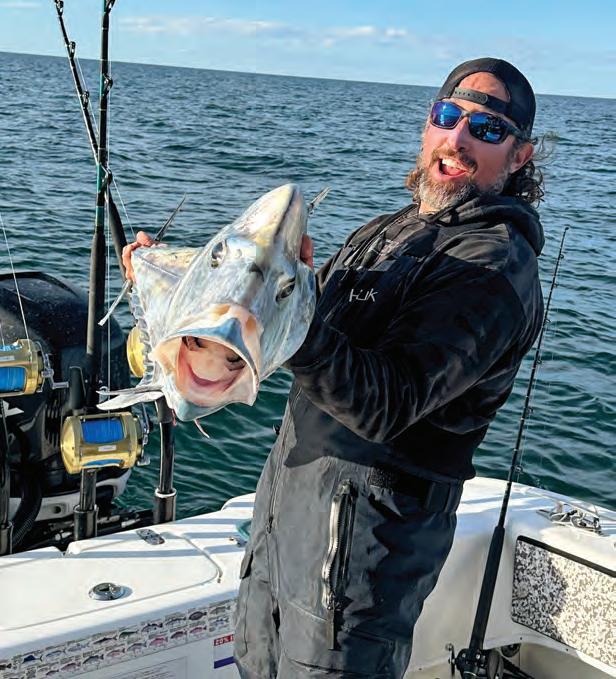

“After passing over endless schools of blue runners and prolific bottom structure, I pulled into a spot that had previously produced wahoo,” recalls Capt. Daniel. “The sonar was marking fish from top to bottom.”
As two anglers at the bow dropped sabiki rigs to collect live bait, their lines became hopelessly entangled. While the captain worked to untangle the mess of braided line, angler Mike Lorenz noticed something interesting on the sonar screen. He dropped down an old, paint-
The mystery fish made several blistering runs, nearly spooling Lorenz’s reel multiple times. The battle switched between long runs and deep, powerful dives under the boat. “It felt more like fighting a huge grouper when it was beneath us,” says Lorenz. “I think both the fish and I were taking breaks between rounds.”
Capt. Daniel maneuvered the boat to help chase down the fish. After an intense fight, a massive silver flash appeared near the surface, prompting the captain to shout “AP!”
The prize—a massive African pompano— was finally secured with a well-placed gaff shot by Capt. Daniel. The crew gathered for photos,
trophy, a testament to both the fish’s size and the memorable nature of the catch.
What began as a “cursed” day of wahoo fishing transformed into the catch of a lifetime, proving once again that sometimes the best fishing stories come when plans go sideways and anglers remain ready for whatever opportunity presents itself.
Brandon Shoaf is Co-Publisherof Coastal Angler Magazine’s Volusia County edition. Contact him at (386) 260-9600 or volusia@ coastalanglermagazine.com.



Furuno has again raised the bar for the most powerful, easiest-to-use Multi Function Displays (MFDs) with the new NavNet TZtouchXL. Five sizes of MFDs provide all the functionality boaters desire and never-before-seen features.
An all-new chart offering called TZ MAPS sets these MFDs far ahead of the field. Navigators have complete control of data they download, such as raster or vector charts, satellite photos and bathymetric data. Plus, they can select specific areas to keep updated. Objects can be turned on and off in the Layers menu with a single swipe on the display. Users can create custom objects or update charted objects, on the system on the fly. Custom objects can be shared with other users through
offers “off the charts” bathymetric data with contours that can be easily configured to a resolution three times better than anything else on the market. Bathymetric data can be overlaid onto navigation charts. All of this can be rendered with custom color palettes and terrain shading.
Purchase of TZ MAPS areas also unlocks AI Routing to plan routes. The free TZ iBoat app for mobile devices allows at-home planning that transfers to TZtouchXL. With a free TimeZero account, waypoints and routes can be backed up or retrieved from the cloud. Charts can be purchased directly from the MFD!
DRS Radar connection unlocks two new safety features: Risk Visualizer™ and
AI Avoidance Route™. These two features provide 360° representation of collision risks and a route around them that can be sent to a Furuno NAVpilot autopilot.
The series comprises five MFDs with displays from 10” to 24”. All feature a powerful hexacore processor for lightningfast response.
All magnetron or Solid-State Doppler Radars, high-powered Fish Finders, AIS, Autopilot, and Deep Water Multibeam Sonar options of NavNet TZtouch3 are compatible with TZtouchXL. Many of the must-have features are also available, including Target Analyzer™, Bird Mode, Rain Mode, and PIN Code Lock. The TZT10X, TZT13X, and TZT16X feature a built-in 1kW TruEcho CHIRP or CW Fish Finder and built-in 235kHz or 455kHz CHIRP Side-Scan. Two new remote-control options are also available.

To learn more, visit: www.NavNet.com


You got new charts! Explore the ocean with vibrant terrain & depth shading, using all-new TZ MAPS. Don’t just take our word for it. See for yourself. Scan here, and we’ll show you!
I’ve been incredibly blessed to fish with some of the best anglers on the planet, guiding me through my journey. To complete that journey, I always keep a couple of rods in my truck, ready to fish farm ponds, lakes, and rivers during my travels as a Boat Lift US salesman. It brings me back to my roots.
Last month marked my 64th birthday, and I find myself enjoying the simple fishing of my youth more and more. Don’t get me wrong—I still love a gag grouper or wahoo bite like Peter loved our Lord—but I also love catching whatever is in season. March can be a slow month for nearshore and offshore fishing, making it the perfect time to switch focus to hickory and white (American) shad in our rivers.
These fish are truly amazing. They leave the coastal rivers of the eastern U.S., migrate to Nova Scotia, take a hard right into deep waters, then journey back south to spawn in the rivers of their birth. Their migration mirrors that of Pacific salmon, using an innate GPS to find their way home. They travel in vast schools, surviving intense predation, just to return to their spawning grounds.
Knowing this, I position myself to take full advantage of this mass migration. I fish for shad in Virginia, North Carolina, and
Tim Barefoot

South Carolina, learning their seasons over the years. Hickory shad arrive first—smaller but plentiful—making them perfect for introducing kids to fishing with non-stop action. When the larger white shad show up, it’s game on. These fish pull hard in the cold water, fighting until the moment you unhook them.
I strongly recommend mashing down the barbs on your hooks to make dehooking easier. Let’s be honest—most anglers aren’t
eating shad, so reducing injury before release just makes sense. Also, always wear eye protection when fishing for these powerful fish. A jig popping free near the boat can come flying back at the angler, as my son learned the hard way in a recent trip to the James River.
White shad will be in rivers all the way down to Florida this month, so if you’re looking for a fun fight on light tackle, now is the time. Check out my YouTube channel for the tackle and techniques I use to catch these childhood favorites.
And, as always, take plenty of videos of your kids—they’ll cherish those memories later in life.
For more from Tim Barefoot, visit barefootcatsandtackle.com and check out his YouTube channel.
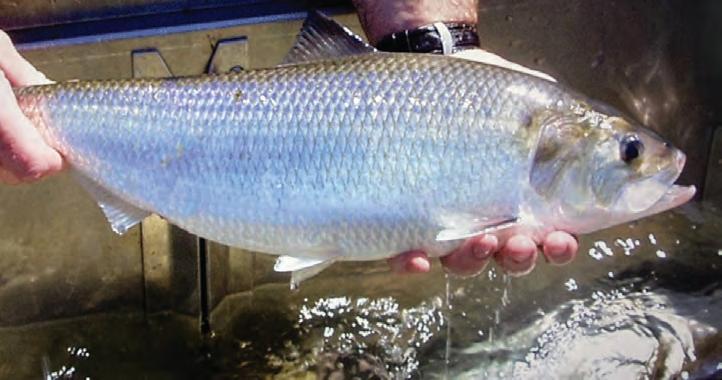
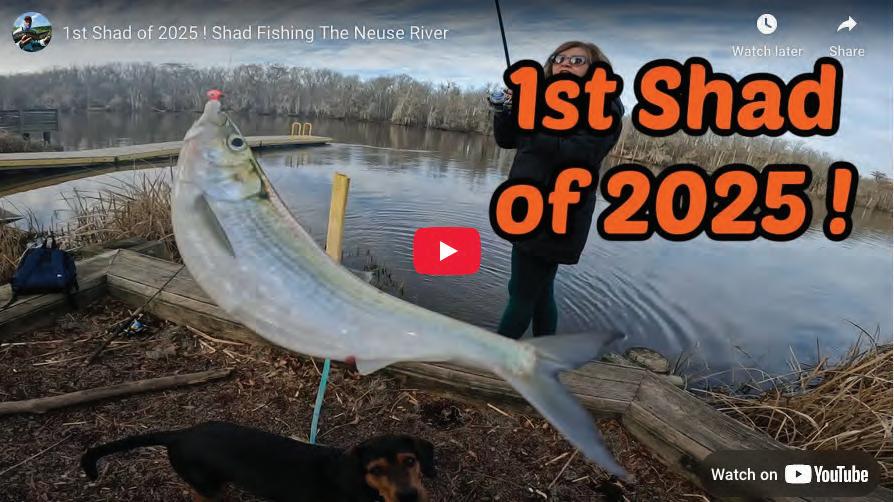

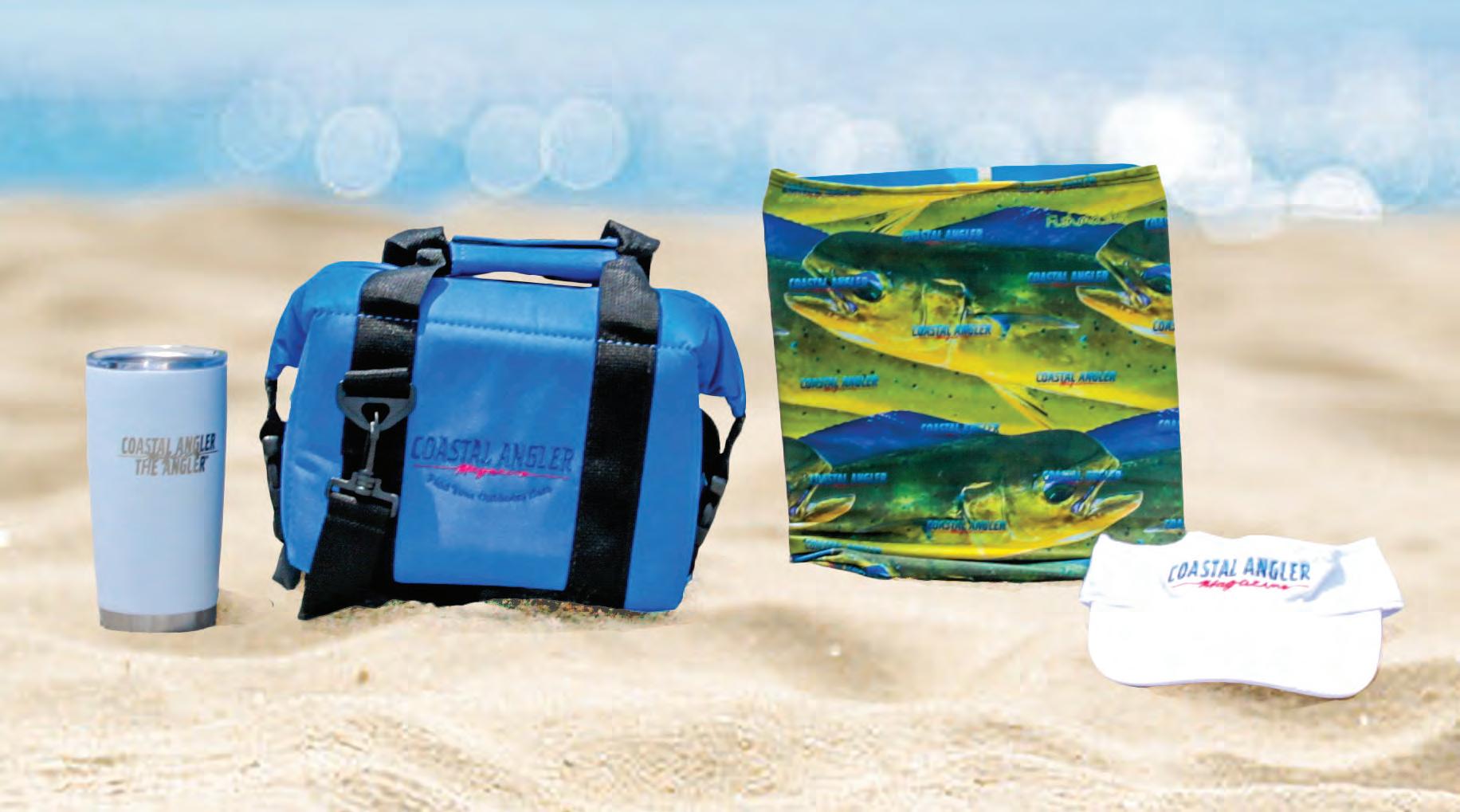
20oz. Ice Retention Slide Mug, AO Cooler, SPF 50 Fish Mask, And A Visor!
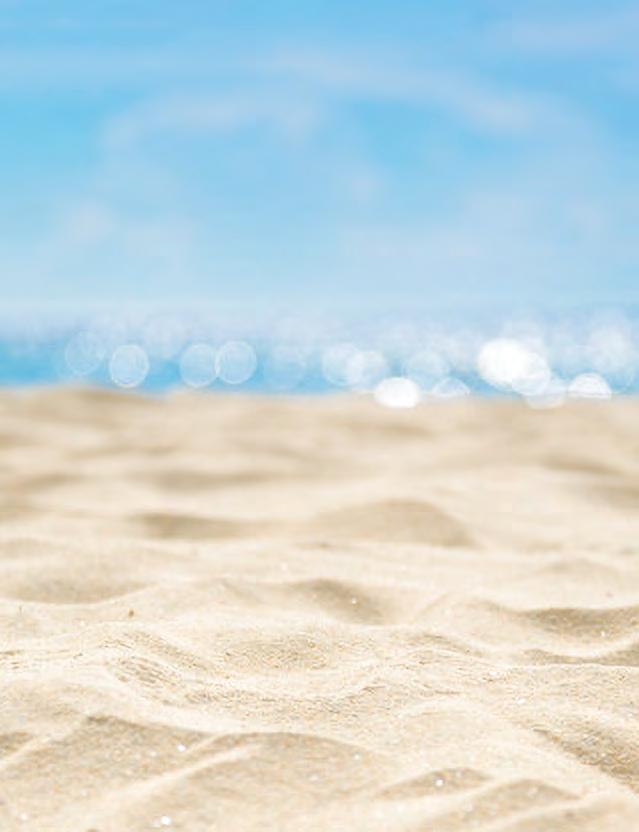

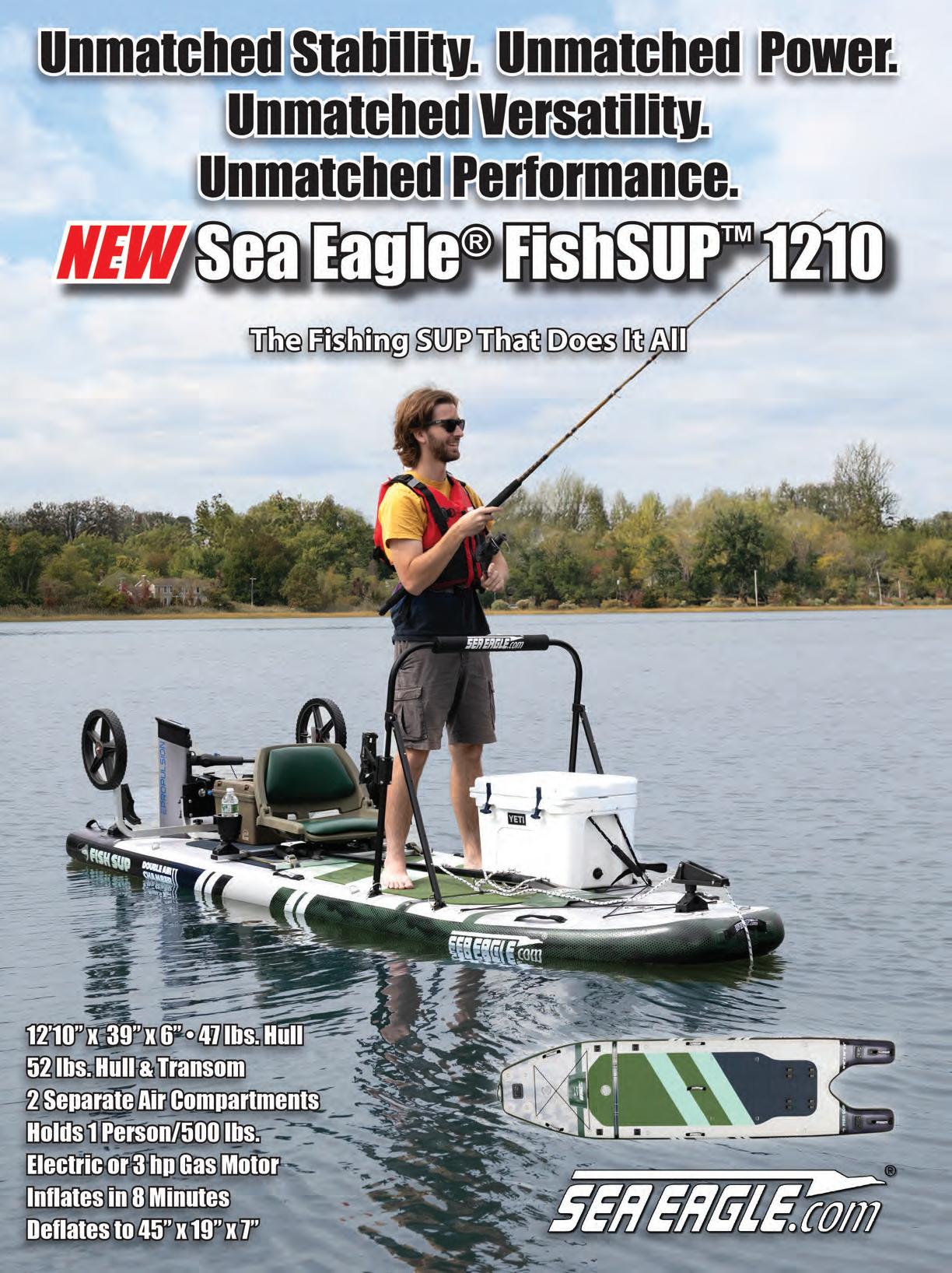
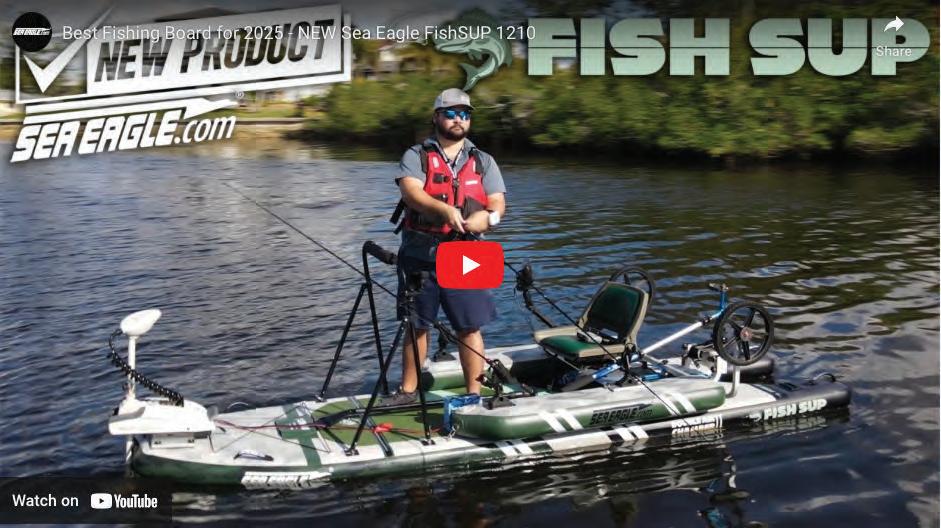
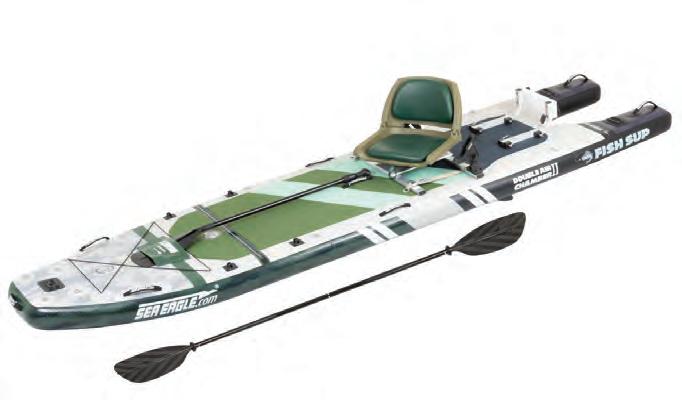
It’s time for anglers to get excited. The new inflatable Sea Eagle® FishSUP™1210 is for the angler who likes to keep it simple as well as for the angler who likes to bring it all. At 12’10” long x 40” wide x 6” thick, the super stable FS1210 can easily be used as an iSUP with just you, a paddle, and your rod or it can be rigged with a swivel seat, electric or 3hp motor, casting bar, rod holders, carting wheels and still have space to spare for all your fishing gear.
Sea Eagle® has offered the popular but smaller FishSUP™ 126 for about 6 years and has just updated it making it slightly longer and widening the shape of the bow as well as redesigning the overall look of the board with new graphics. There are some important safety points to mention about this fishing iSUP. It has 2 independent air chambers that inflate
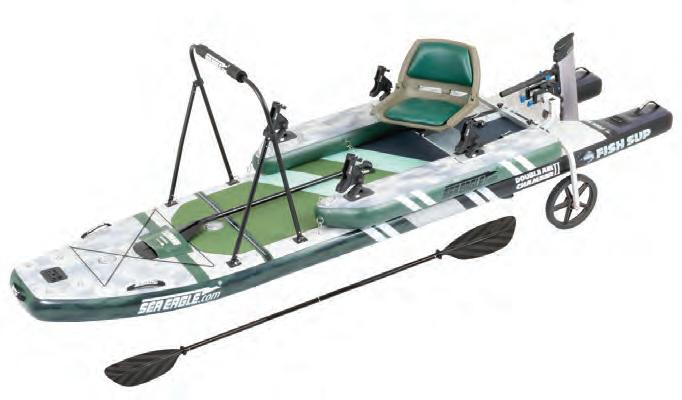
to a rock solid 15 psi, insuring anglers have a safe fishing platform. The swallow tail pontoons extend 24” behind the removable motor mount adding to the stability and buoyancy of this iSUP. Other cool standard features include a paddle pocket that keeps your paddle secured and out of the way when not in use or when carrying the board, built-in 36” fish ruler, and shock cord at the bow to keep gear in place. There’s also an EVA foam deck pad for a nonslip surface, multiple d-rings to secure gear and a seat, multiple carry handles, and 3 preinstalled Scotty® bases that accept a multitude

of Scotty® fishing accessories.
If you want to really deck it out, though, Sea Eagle® offers several exciting options for the FishSUP™ 1210 including a removable motor mount and removable wheels that can be quickly lifted up and locked in place when you’re in the water. You can attach a swivel seat to the board itself, or opt for the side tubes that quickly lock into place and lift the seat 6” giving you a perfect view of the water, comfortable seating, and a great spot to cast from.
Sea Eagle® has been making inflatable kayaks, boats, SUPs and canoes since 1968. They know exactly what the customer is looking for as can be seen with the new FishSUP™ 1210 that’s made specifically for anglers. It’s available in 6 package options from the simple board & paddle all the way up to side tubes & motors.
By Capt. Michael Okruhlik



Spring fishing brings its own set of challenges and opportunities. As water temperatures rise, targeting inshore species like trout, flounder, and reds requires adapting to their changing behavior. Early spring often means downsizing lures. As fish feed on tiny baitfish and shrimp, small lures mimic these natural prey more effectively. Large trout and reds may already have full stomachs, expelling small bait when caught, signaling the need for a smaller offering to match the size of the food they’re consuming.
With the warming water, fish become more aggressive, and it’s time to speed up your retrieval techniques. After a slower winter, anglers should bring out fasteraction rods and smaller versions of topwater and twitch baits. While spring can bring calm days, cool fronts and high-pressure systems still affect fish behavior. When this happens, adjusting to the conditions— rather than just relying on the calendar—is key. Opting for colors like white or silver for hard baits can pay off during this time.
However, spring also brings stiff winds and crowds. In South Texas, gusts can reach up to 30 knots, making conditions challenging, especially for kayakers. It’s crucial to check the forecast and plan for these challenging winds. Additionally, spring break brings an influx of boaters and kayakers, many of whom may be rusty from the off-season. Defensive driving and boating have become essential, and leaving early is recommended to avoid congestion at ramps and on the roads.
Conditions are still variable when targeting fish in March. The water can remain chilly despite warmer air temperatures. Cold fronts affect fish behavior, making them seek deeper water with more stable temperatures. While some fish may move closer to flats as the day warms, they rarely stray far from deep water. Focus on areas near the outer edges of guts that lead from deeper water to flats, adjusting as the day progresses.
During high-pressure conditions, downsizing lures remains reliable, especially as young forage species become abundant. Natural or translucent colors work well; slowing the retrieval to keep lures closer to the bottom can increase success. When this approach doesn’t yield results, switching tactics can help. Using noisy lures, such as rattling crankbaits or loud topwaters, can provoke a reaction bite when fish are less willing to chase actively. Experimenting with these extremes—quiet, slow presentations versus noisy, aggressive ones—can help you find the right approach in high-pressure situations.
Spring fishing requires patience, adaptability, and a keen eye for weather and water conditions. Whether you’re dealing with shifting fish patterns or navigating spring break crowds, it’s a great time to get out on the water—and maybe bring a kid along for the adventure.
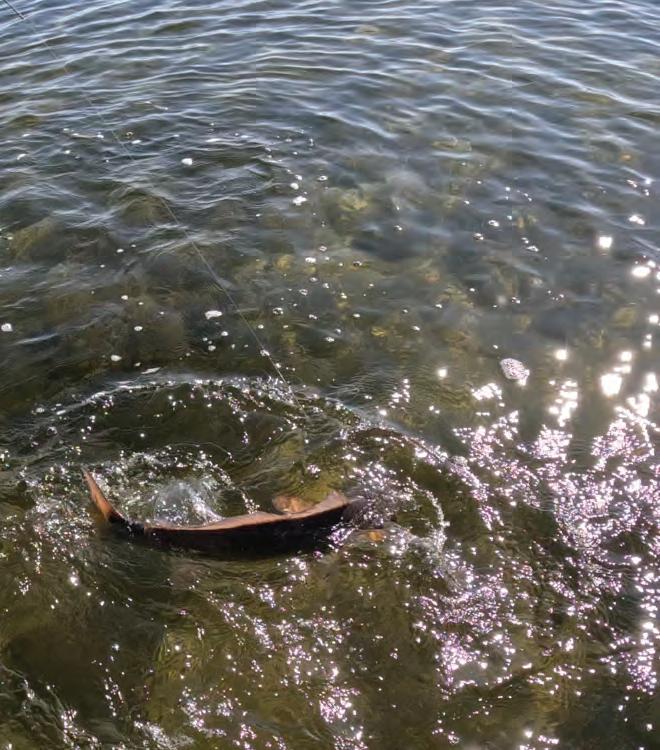

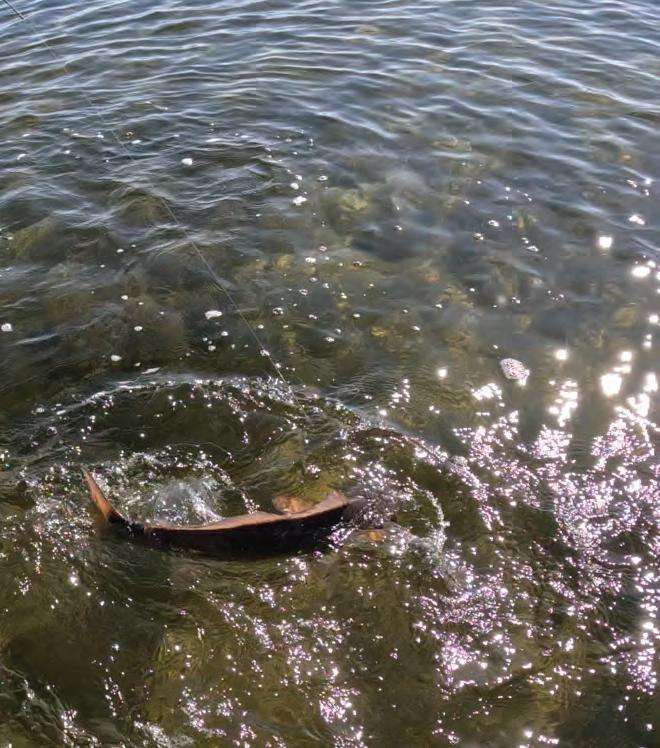











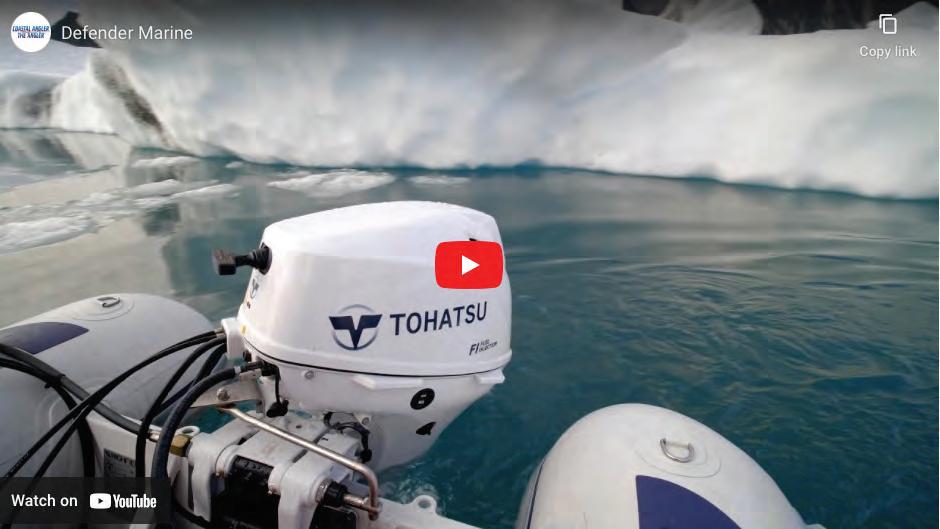
Experience the power of innovation with Tohatsu outboard motors. These lightweight, compact engines redefine portable power for boating enthusiasts. Unmatched Performance and Convenience
• Power-to-Weight Ratio: Optimized for small horsepower applications.
• Reduced Noise and Vibration: For a smoother, quieter ride
• Multi-Function Tiller Handle: Integrates essential controls for ease of use
• Power Tilt Options: Available on remote steering/throttle models.
Defender
Defender offers quality marine supplies, inflatable boats, and outboard motors. Our mission is to make boating more accessible with our vast catalog, fast shipping and expert service. That’s how we continue to earn the trust of mariners worldwide since 1938. Defender provides an extensive range of inflatable boats, outboard motors, and a comprehensive selection of boating accessories and gear to customize your vessel to your preferences. From bilge pumps and life jackets to dock lines and electronics, we supply all the essentials to prepare you for the water.
Explore Tohatsu’s range of portable outboard motors at Defender.com, our Outlet Store in Waterford, CT, or call our experienced team at 800-628-8225



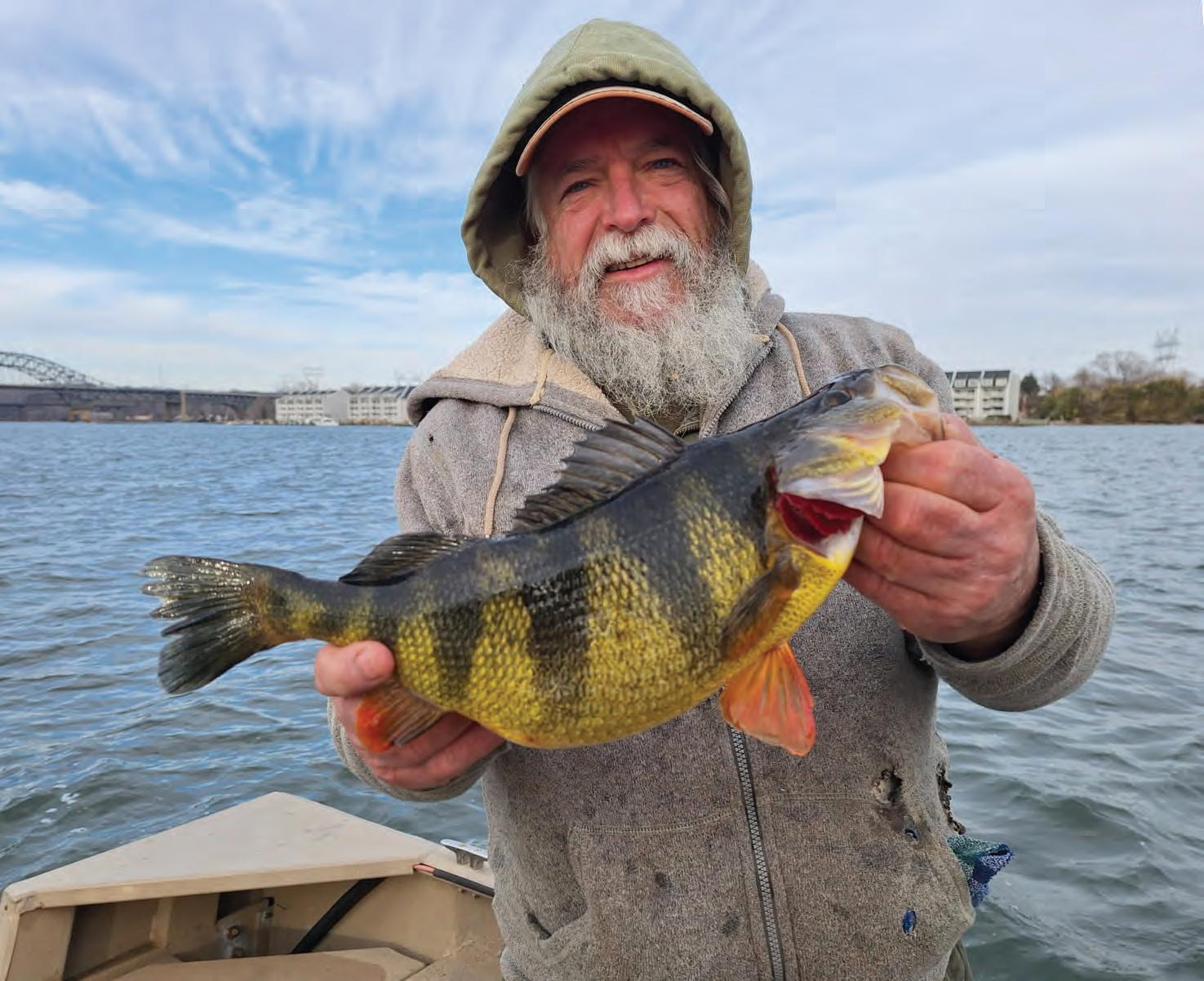


The Maryland Department of Natural Resources recognizes Thomas Dembeck Jr. of Hydes as the new state record holder for yellow perch – Perca flavescens – in the Chesapeake division.
Dembeck caught the 2.3-pound, 16-inch fish on February 7 while fishing in the tidal waters of the lower Susquehanna River. He was deep jigging in about 50 feet of water using a doublejig rig, which consisted of two small 1-inch plastic paddletails on ⅛-ounce leadheads rigged on dropper loops above a 1-ounce sinker. He was using a light spinning rod with ten-pound test braided line. Dembeck’s catch bested the long-standing record of 2.2 pounds, caught by Niles Pethel on November 21, 1979.
The fish was weighed on a certified scale at Gibby’s Seafood in Lutherville, and the species was confirmed by DNR recreational fisheries coordinator Erik Zlokovitz.
Dembeck has fished for yellow perch since the 1960s and catching a state record fish has been a lifetime pursuit. On the day he caught the record, he had been catching mostly small yellow perch. When he felt a slightly heavier weight on his line, he first thought it was just a double-header of two small fish.
“I was nonchalantly reeling the fish towards the surface and even took time to watch an eagle fly by,” Dembeck said. When he looked down, he saw a perch that looked like a big “yellow submarine” and yelled for his friend
Lee Haile to net the fish. Haile, the current state record holder for chain pickerel in the nontidal division, realized they might have a state record yellow perch in the boat. After approximating the fish’s weight on a hand scale, they took it to a certified scale for an official weight.
The Department of Natural Resources maintains state records for sport fish in four divisions: Atlantic, Chesapeake, Nontidal, and Invasive. Anglers who think they have a potential record catch should download and complete a state record application and call 443-569-1398. The department recommends the fish be immersed in ice water to preserve its weight until it can be checked, confirmed, and certified.

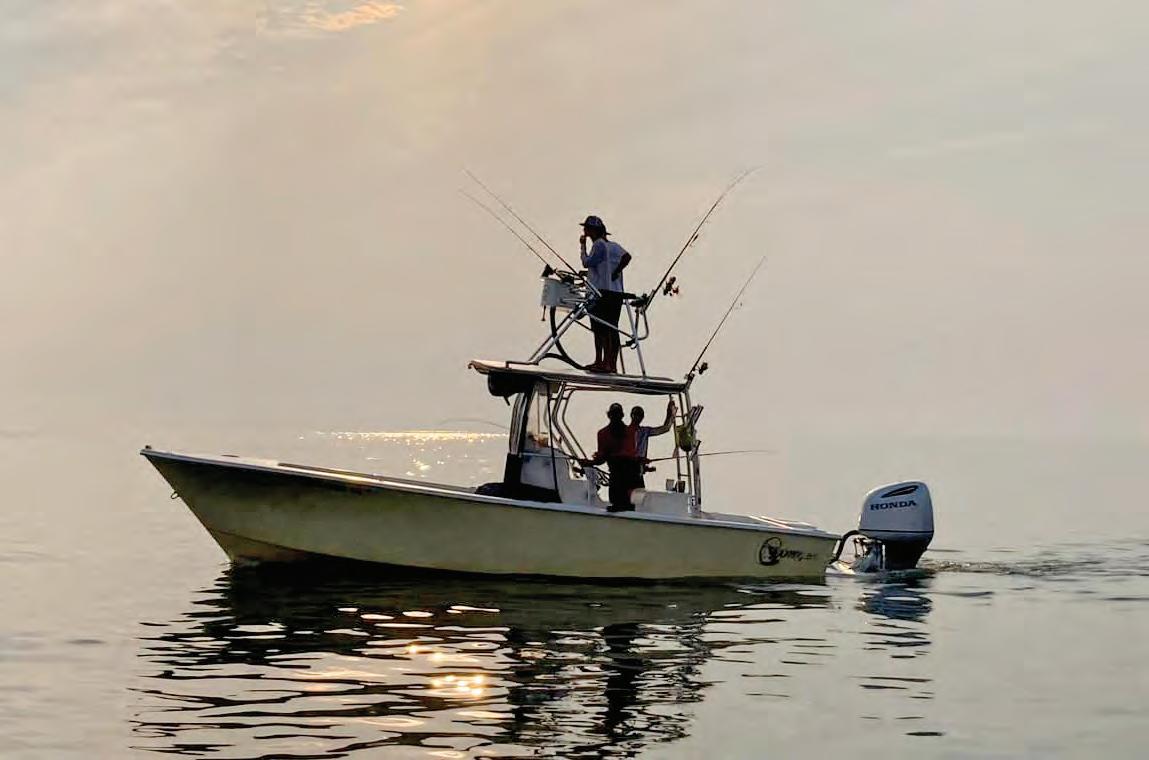








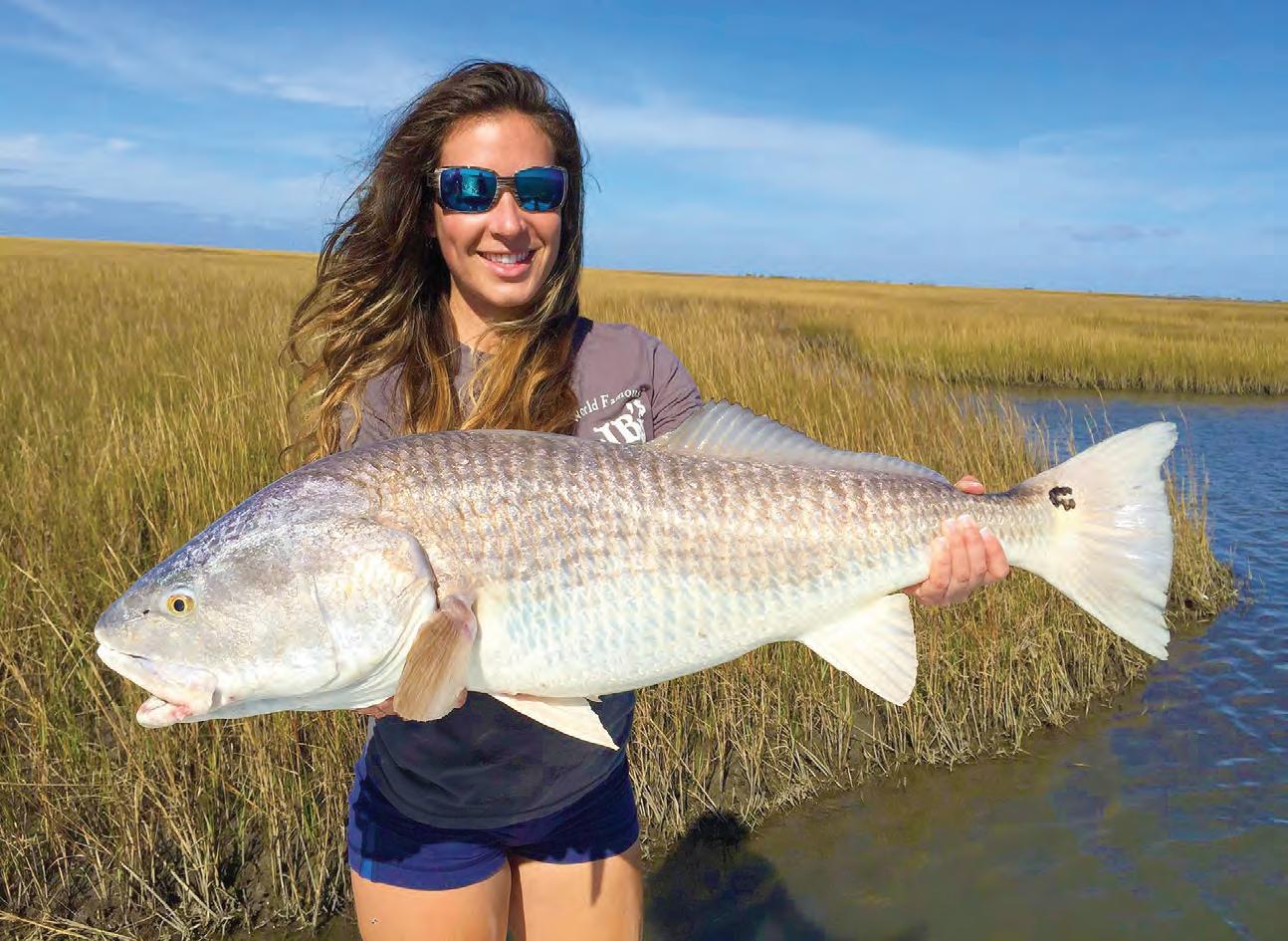
Ifind myself staying in the strangest places when I go on fishing adventures. But as long as it involves fishing, sleeping on a couch or on the ground really doesn’t matter.
On this particular trip, my friends and I found ourselves in a small houseboat on a river in the Louisiana marshes west of New Orleans. It was tiny, there was only one bathroom (picture four girls trying to use one bathroom), and the bed sheets smelled like a man after a long day of fishing. You might be wondering what brought us to such a place, and I will give you two very good reasons: redfish and black drum. Enormous specimens of these two drum species come into the marsh each fall and winter, 20 to 30 pounds to be more specific.
If you plan on making the trip to Louisiana to do some inshore fishing, it is not necessary to stay on a houseboat; however, I highly recommend it. When you wake up each morning, you are on the water ready to fish with your boat tied up next to you.
Of the drum family, redfish seem to be the
By Jacki Shea


most popular inshore species. Redfish are always a great fight, especially the big bulls. But many anglers seem to overlook black drum, which are sometimes referred to as a “mud donkeys.” It is not an attractive fish, nor is it great for eating; therefore, it is not commonly targeted. This fish does, however, grow the largest of the drum species, and it fights with the same action and power as a bull red. Now that I’ve caught a few, I believe black drum can look very pretty once the Louisiana sun hits those scales just right. Redfish and black drum are thick in the Louisiana marshes all year, but the season for the monsters runs from September to January, when big fish move from offshore into the marsh following migrating baitfish. When the baitfish show up inshore, the big fish won’t be far behind. For bait you can use live or artificial depending on whether you are trying to sight fish or just toss a line out and wait. On our trip, we used a standard knocker rig, with an egg sinker and a
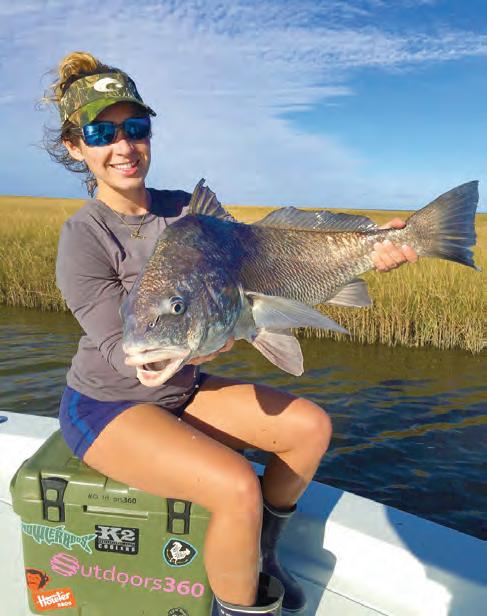
hook, and sank split live blue crabs and shrimp to the bottom and waited.
The fishing is quite simple when you know where the fish are, although a guide is recommended for those unfamiliar with the waters because it’s easy to get lost in the marsh. Keep an eye out for cold fronts. The cold fronts cleanupthewaterandbringthefish closer to the surface, which makes for perfect sight fishing. The fish also enjoy the cooler inshore water, so they will be more abundant and active.
Check out Jacki’s YouTube channel @captjackishea for videos of her fishing adventures.
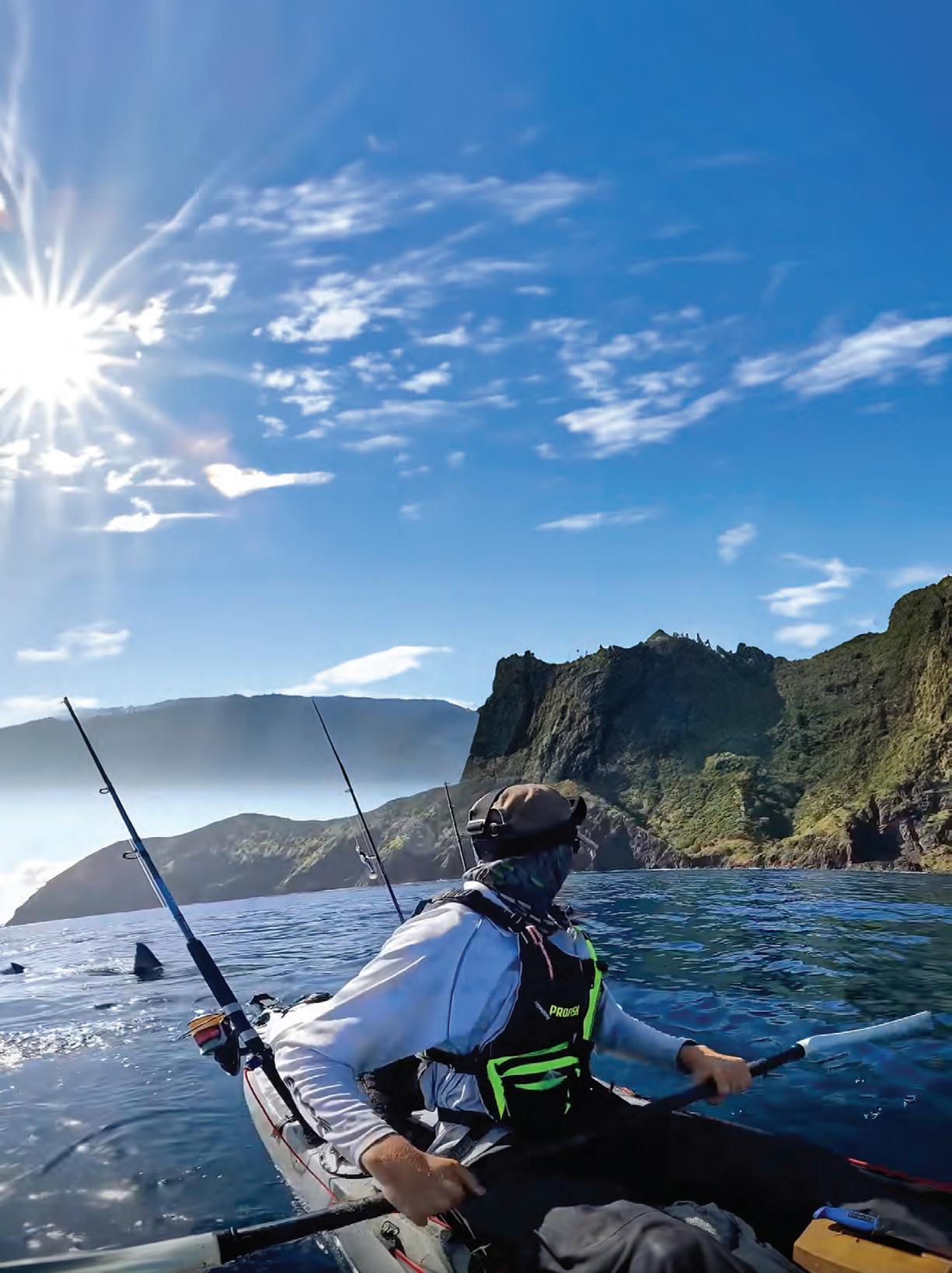



In this captivating video, a kayak angler experiences an unexpected and thrilling encounter with a great white shark that follows him for miles. The footage captures the majestic yet intimidating presence of the shark as it glides through the water, showcasing its size and agility. Throughout the journey, the angler maintains a mix of excitement and caution, providing viewers with an adrenaline-pumping perspective on the encounter. The video highlights both the beauty and power of marine life, reminding us of the delicate balance between humans and nature in the ocean.
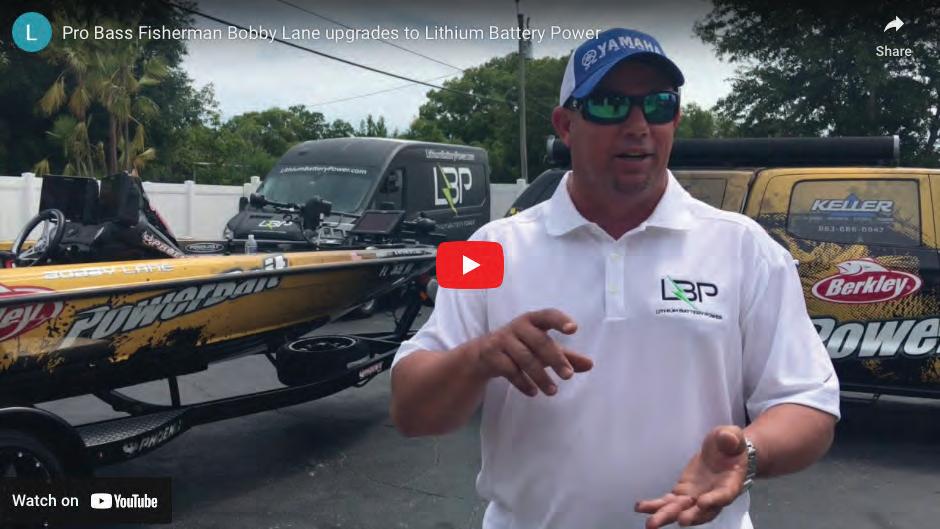

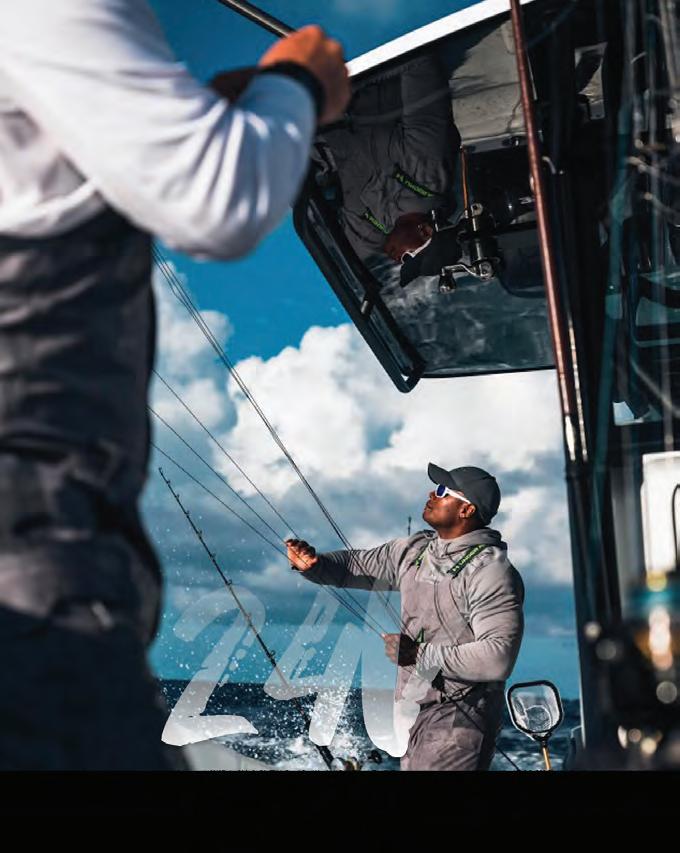




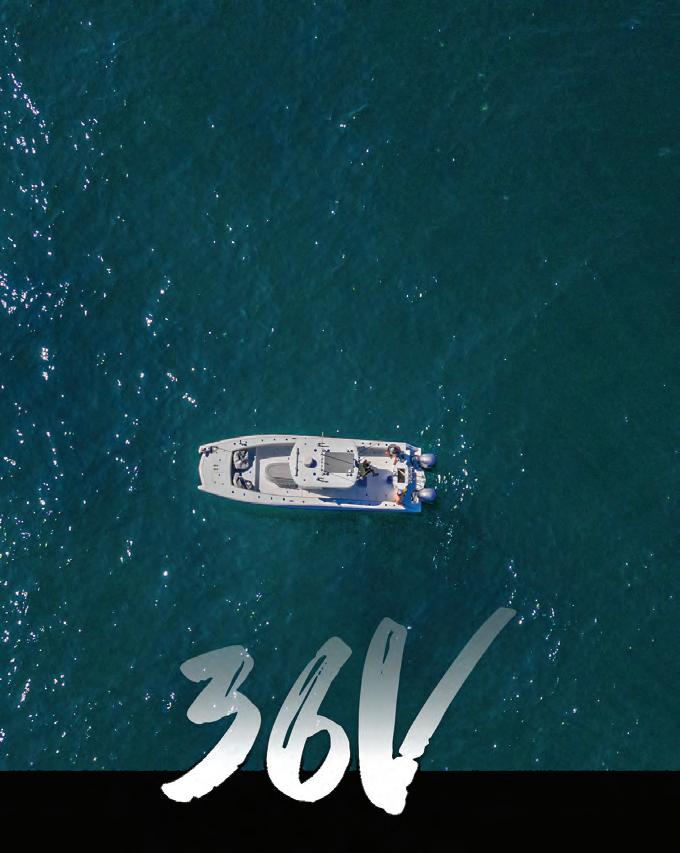






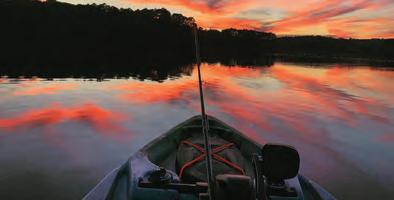
When it comes to freshwater fishing, Tennessee has an embarrassment of riches. From massive rivers and reservoirs to small ponds and high-elevation trout streams, the state is home to incredible fishing opportunities. Tennessee State Parks are excellent base camps for on-the-water adventures. They offer amenities for lodging or camping, and many of them are right on the water, with unparalleled access to some of the best fisheries in the nation.
Here are a few great Tennessee State Park fishing destinations:
• ROAN MOUNTAIN STATE PARK: Fed from elevations of around 6,000 feet, the Doe River runs clear and cold through the center of Roan Mountain State Park. Its tributaries are home to healthy year-round populations of native brook trout and both wild and stocked rainbows and browns.
The 2,000-acre park is dominated by hardwood forests and rugged ridgelines. It is a beautiful place to be, whether you’re casting flies or just camping and going for a hike.
• HARRISON BAY STATE PARK: Just outside of Chattanooga, Harrison Bay is a 1,200-acre park with 40 miles of shoreline on Chickamauga Lake. If you’re a bass angler, you know “The Chick’s” reputation as a big-bass factory. It is ranked among the best largemouth fisheries in the world.
The massive reservoir is also a great fishery for smallmouth bass, striped bass, crappie, walleye and big Tennessee River catfish.
• ROCK ISLAND STATE PARK: North of McMinnville, Rock Island is an 883-acre state park on the headwaters of Center Hill Lake, where the Caney Fork, Collins and Rocky rivers meet. These rivers and the lake itself are some of the best fisheries in this part of the world for “The Fish of 10,000 casts.” If the mighty muskellunge is on your hit list, this is a good place to chase one.
The park is also a fantastic place to catch walleye when the rivers fill up with spawning walleye in early spring. There’s plenty of bank space to fish from, and it’s a great area for kayaks, canoes and boats.
• NORRIS DAM STATE PARK: A short drive from Knoxville, Norris Dam State Park is 4,000 acres on Norris Lake. The lake is renowned for excellent smallmouth bass fishing as well as good fishing for largemouth bass, catfish, striped bass and walleye.
If that isn’t enough get you excited, the Clinch River downstream of Norris Dam is one of the best tailwater trout fisheries in the Southeast.
These four Tennessee State Parks are just the tip of the iceberg. With fishing as a primary draw to more than 40 state parks in the volunteer state, you’ll need to do some research to plan your next adventure. For information, visit tnstateparks.com.
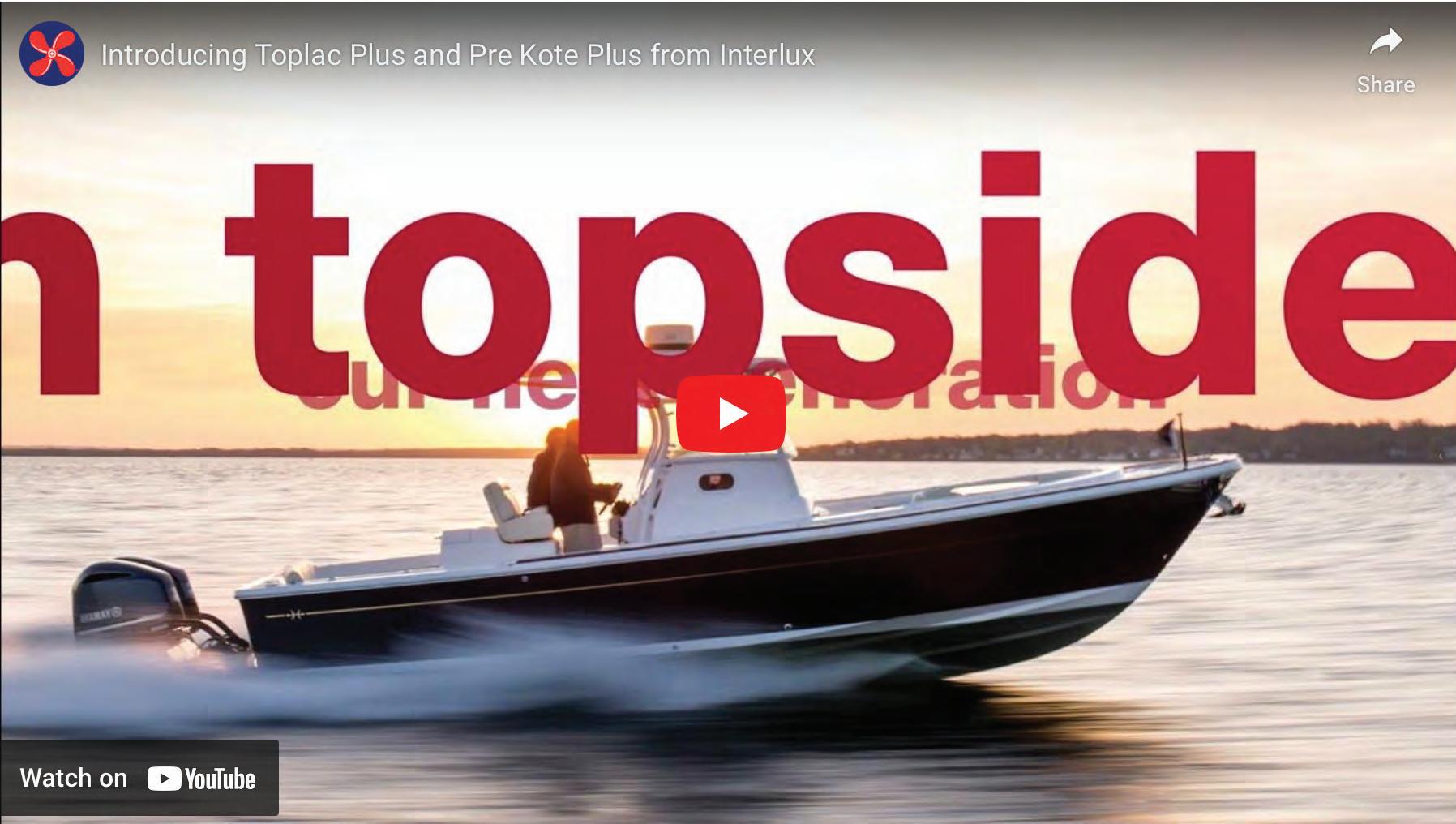



Introducing our next generation, premium topside system with professional level results in an easy to use one part finish.
Toplac ® Plus provides a best in class high gloss finish with longer lasting UV protection that is easy to apply with exceptional roller application, without the need for tipping, available in a full range of vibrant colors. Apply over Pre Kote ® Plus, our improved one part undercoat and topside primer all in one, with substrate protection, an extra smooth finish, and lower VOCs. An amazing finish has never been so easy. Experience a revolution in topside paints, from Interlux®. Relentless performance for every boat, everywhere, every time.

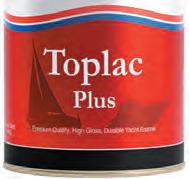
interlux.com


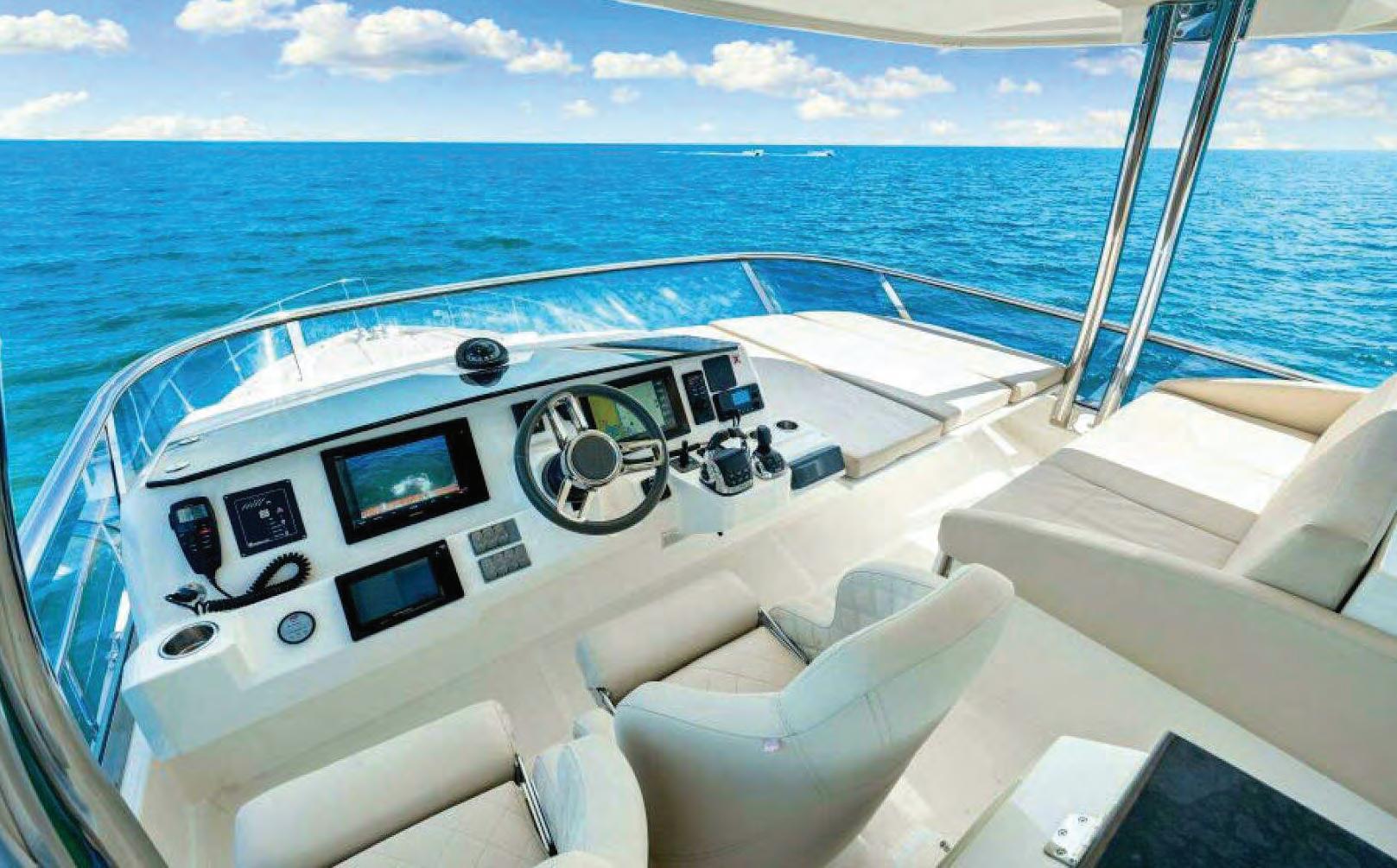
The recreational fishing industry is on the brink of a technological revolution, with autonomous boating emerging as a transformative force. While self-driving cars have dominated headlines, the development of autonomous boats is quietly reshaping how anglers approach their favorite pastime. These advancements promise to enhance safety, efficiency, and accessibility, potentially changing the way people experience fishing forever.
One of the most significant benefits of autonomous boating in recreational fishing is the ability to optimize navigation. Advanced GPS and AI-driven systems can analyze weather patterns, water conditions, and fish activity to chart the best possible routes. Instead of relying solely on experience or guesswork, anglers could have boats that take them to the most promising fishing spots with precision. This technology reduces the time spent searching for fish and maximizes the chances of a successful outing.
Safety is another critical aspect that autonomous boats could improve. Many fishing accidents occur due to human error, whether it’s navigating unfamiliar waters, dealing with sudden weather changes, or simply losing focus. With AI-driven controls,
boats could automatically adjust speed, avoid obstacles, and even return to shore if conditions become too dangerous. This level of automation provides an added layer of security, especially for solo anglers who might face emergencies without immediate help.
Accessibility is another area where autonomous boats could make a profound impact. For many, operating a traditional fishing boat requires skill, physical effort, and extensive knowledge. Those with limited mobility or minimal boating experience often face challenges when trying to enjoy fishing on the water. Autonomous technology could allow more people to participate by simplifying the boating experience. With userfriendly controls or even remote operation via a smartphone app, individuals of all backgrounds and abilities could enjoy fishing without the steep learning curve associated with traditional boating.
The integration of smart fishing technology into autonomous boats could further enhance the angling experience. Innovations like underwater imaging, automated bait deployment, and real-time fish tracking are already making their way into modern fishing gear. When combined with an autonomous vessel, these tools could provide
an unprecedented level of efficiency. Imagine a boat that not only takes you to the ideal fishing location but also adjusts its position based on fish movement, current flow, and water depth. Such advancements could make fishing more productive and enjoyable than ever before.
Despite the promising future of autonomous boating in recreational fishing, challenges remain. The cost of developing and maintaining this technology is still high, potentially limiting accessibility for the average angler. Regulatory concerns also pose hurdles, as governments and maritime authorities must determine how autonomous boats fit within existing laws. Additionally, traditionalists in the fishing community may resist the shift toward automation, arguing that it takes away the skill and personal connection that make fishing special.
As technology continues to evolve, autonomous boats will likely become more sophisticated, affordable, and widely accepted. Just as GPS revolutionized navigation and fish finders improved catch rates, AI-driven boats have the potential to redefine the recreational fishing experience. While the transition may take time, the possibilities are endless, and the future of autonomous boating in fishing looks bright
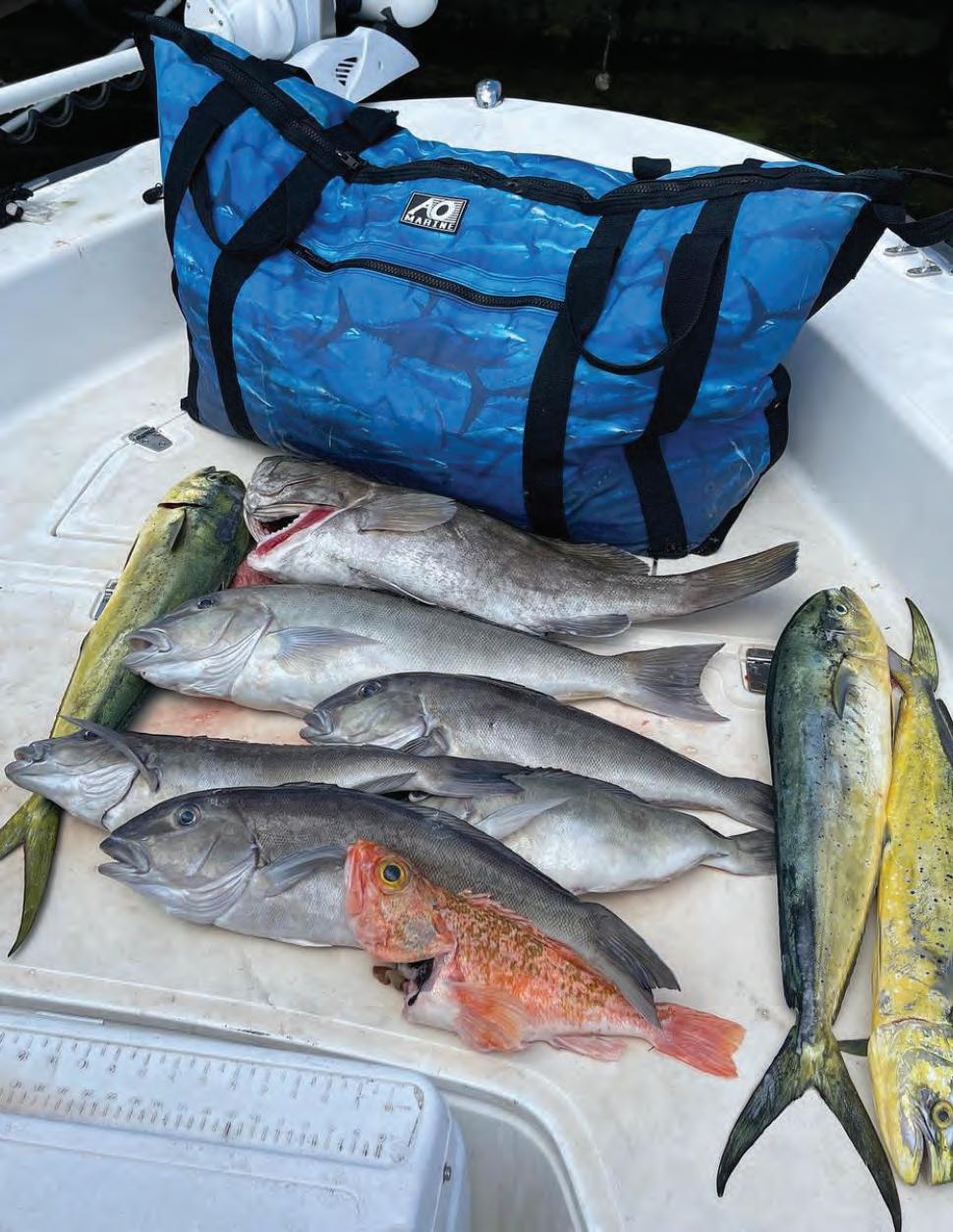
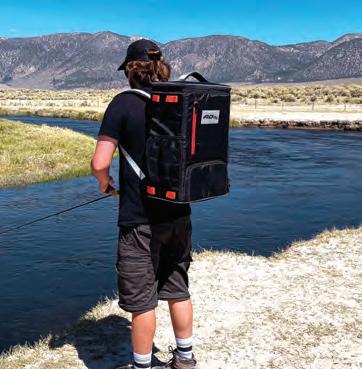



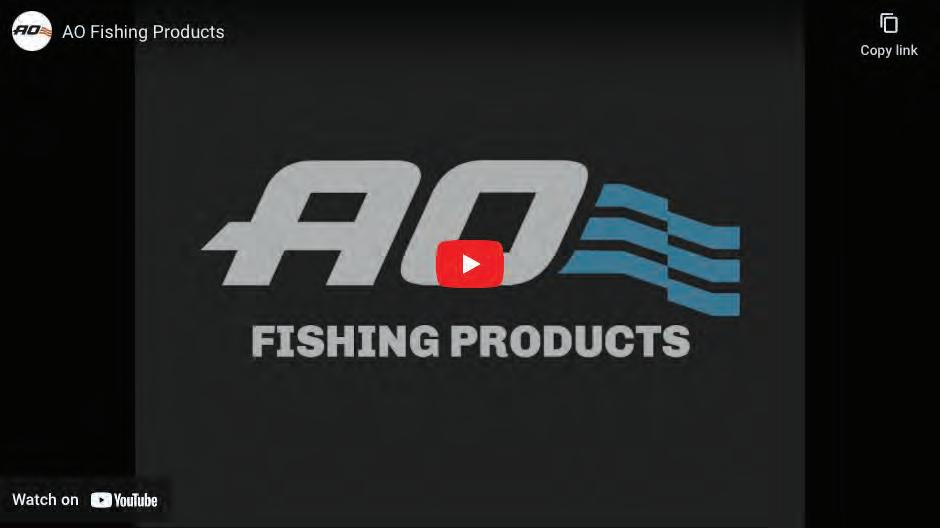

, the leader in high-performance soft-sided coolers, is hitting the water this year with new, upgraded fishing products. Our fishing team partners told us what they needed, and we listened!
Products are in stock and ready to ship; The Fishing Cooler Backpack, 2, 4 & 6ft Fish bags, Fillet bags, Boat fenders, EVA Traction pads, Inflatable Docks, ISUPs, and of course, our high-performance coolers specifically designed for use on boats, guaranteed not to leak, and to keep ice cold for up to 24 hours.
Thirty years ago, AO was launched to provide active, hard-core people with quality products at a reasonable price. We started selling our soft-sided coolers to the hard-core, go-fast boaters and fishermen in Lake Havasu. We aimed to keep ice in our coolers for up to 24 hours in 120-degree Havasu heat. That goal was accomplished 30 years ago, and we’re still at it.
We know our customers; they fish and boat in the summer and ride the dunes or trails in the winter. AO products give those high-octane souls greater freedom to embark on and enjoy what’s important to them.
Make sure that your gear does not hold you back from doing what you love. AO products are built to handle whatever offshore adventure is coming next.
AO is flexibly rugged, seriously fun, and honestly real!
We’re looking for active, adventurous folks that demand quality and performance from their gear. Share your adventure and send us your fish story or photo.

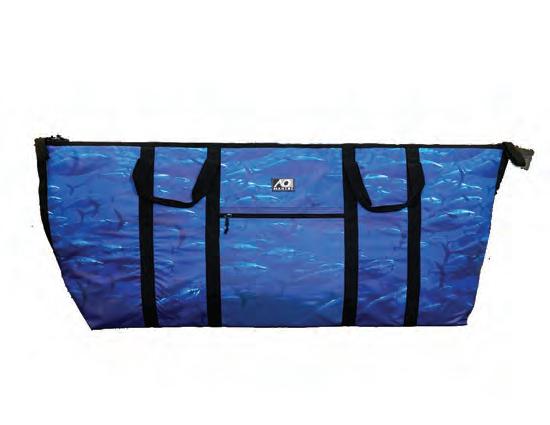


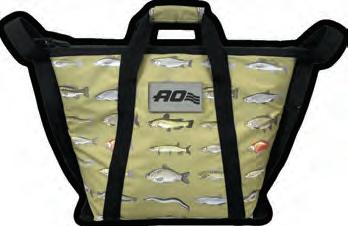

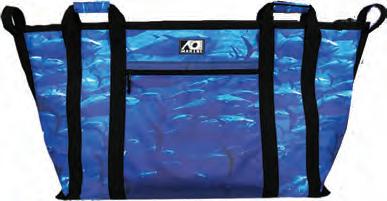
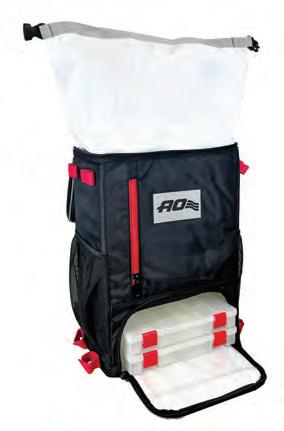

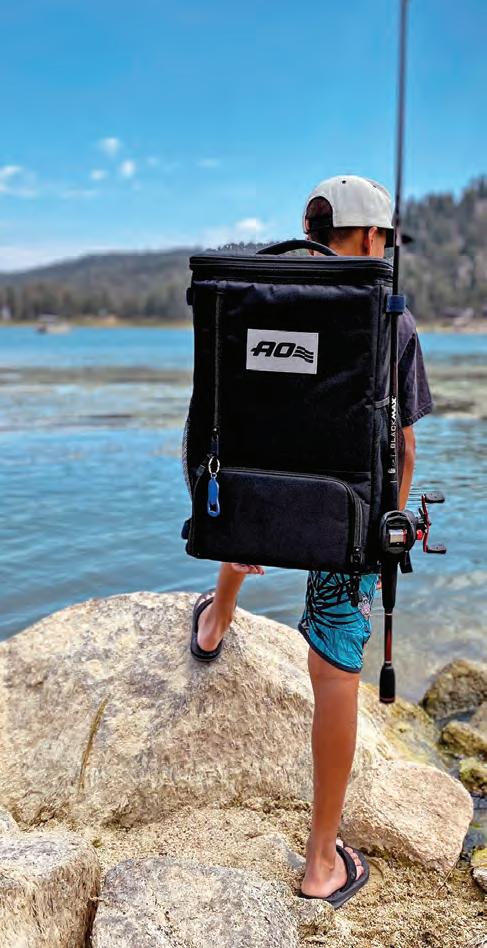
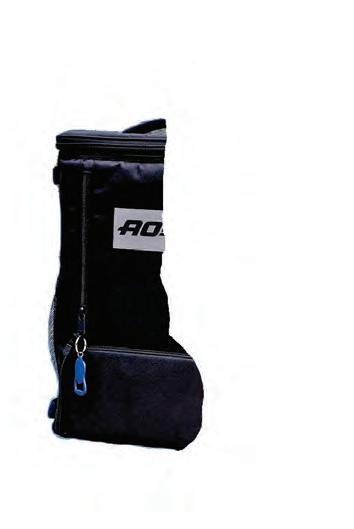


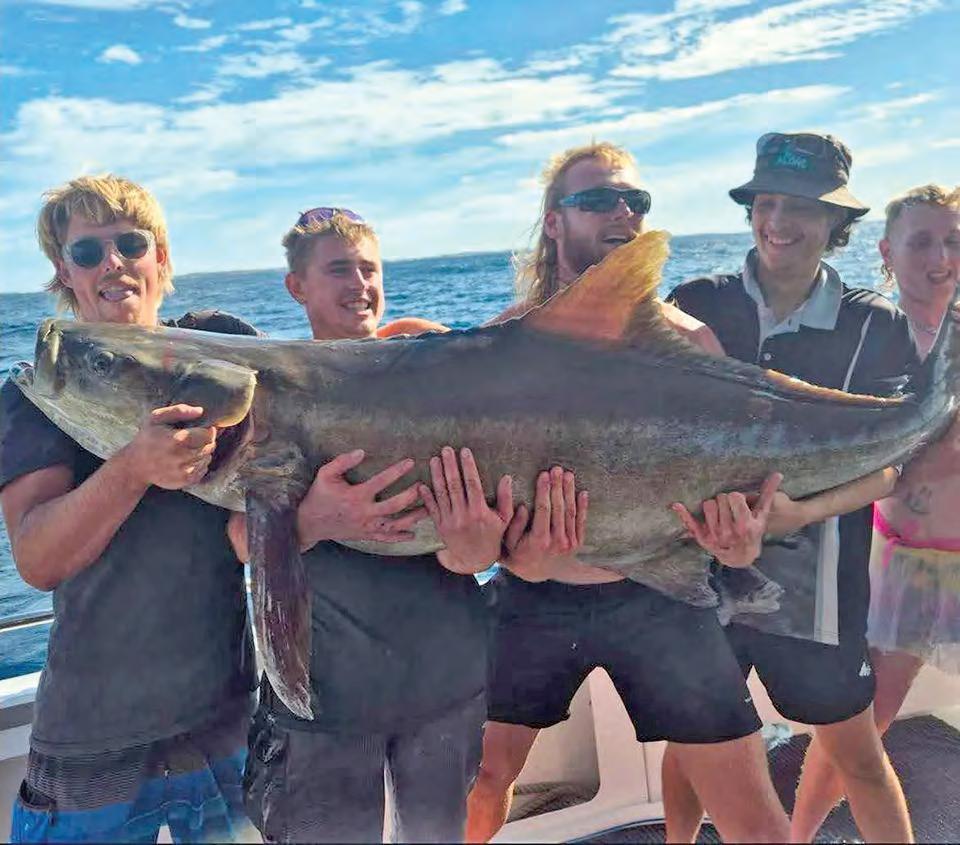
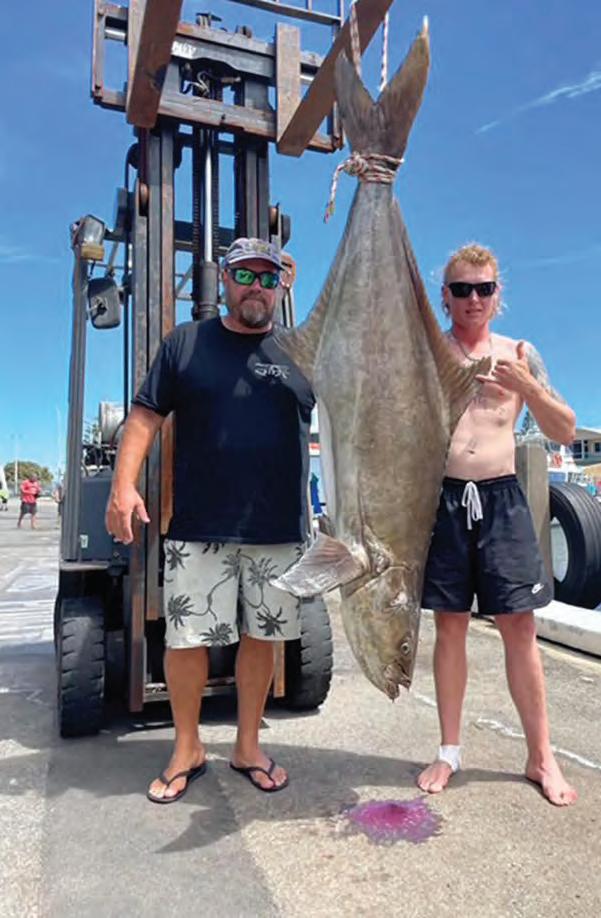
On February 8, a group of anglers celebrating Lucas Tapper’s 21st birthday off Southwest Australia hooked a massive cobia weighing 175.49 pounds. If certified by the IGFA, this catch would surpass the 40-year-old all-tackle world record of 135 pounds 9 ounces. After a grueling fight, angler Koby Duncan managed to reel in the stubborn fish, which is now awaiting record certification and taxidermy.




Forty-nine reservoirs stretch across the Tennessee Valley like a string of pearls. And for those who love to fish, those lakes are just as valuable. Whether it’s bass, crappie, walleye, or catfish, whether for sport, food, or just fun, you can find world-class lake fishing only hours away from any spot in the Tennessee Valley. From more than 11,000 miles of shoreline or while floating on more than 700,000 acres of water, residents and visitors will quickly learn why this area is considered one of the best fishing destinations in the U.S. and, some would say, the world.
Fishing from the shore can be restful and rewarding—and anyone can do it. All you need is a little intel about how to find a spot where the fish might be biting. Here are a few tips for successful shore fishing from the Tennessee Wildlife Resources Agency:
• Fish are often swimming near the shore in the spring and fall. If you’re fishing from the shore in the heat of summer, do it in the evening or early morning—or even after dark.
• Fish near-unique features such as docks, logs, trees, rocks, or rocky areas; aquatic vegetation; or places where creeks enter the water.
• When fishing in moving water, look at the surface for boils and breaks—this means there is some underwater structure blocking the current, which could be the perfect hiding place for fish.
• Begin fishing (casting) close and parallel to the bank, then work your way outward (fan casting) toward deeper water.
• If you don’t get any bites, try switching baits. If this doesn’t work, move to another hole.
• Wear polarized sunglasses so you’ll be able to see fish as well as submerged objects more clearly. (Your eyes will also be protected from the tackle.)
If you love outdoor sports—boating, hunting, fishing—and the natural world, or if you just like to observe wildlife, build birdhouses, maintain a bird feeder or are just curious about the critters in your backyard, the Tennessee Wildlife Resources Agency is here to help enrich your outdoor experience. Visit us at www.tn.gov/twra/




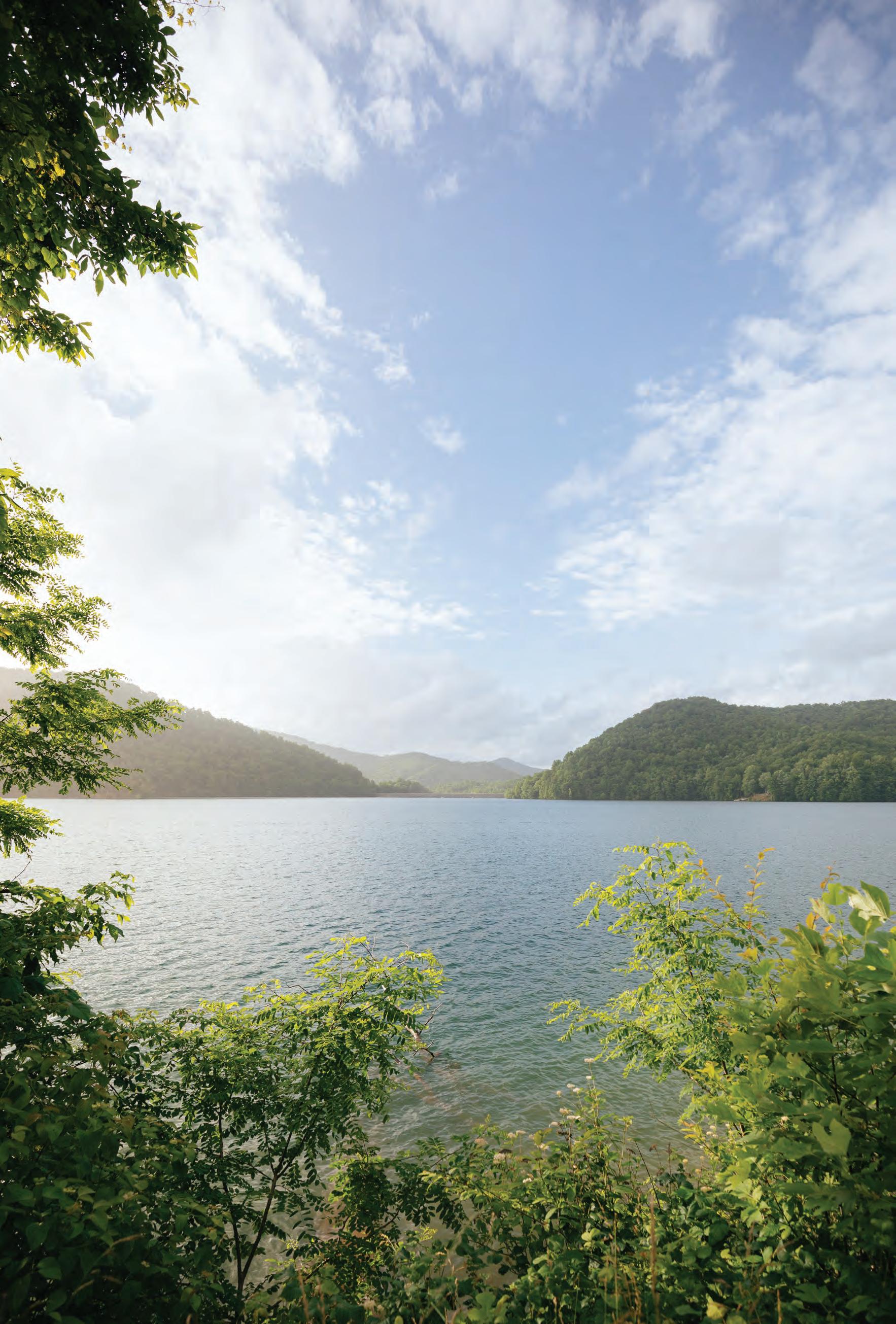
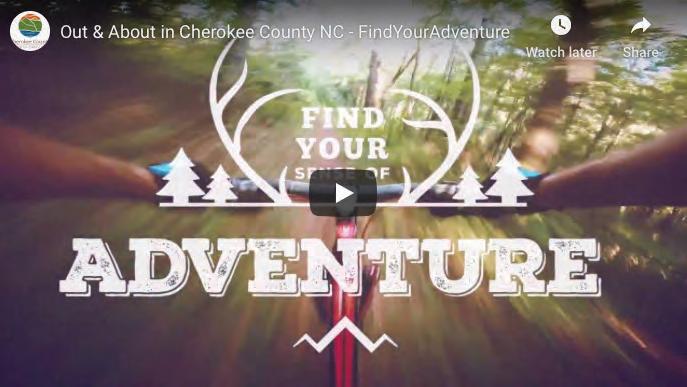
From February through April, bass flood the shallows to spawn, creating an exciting opportunity for anglers to catch monster fish. While various techniques can be effective, fishing with a big worm consistently tempts big, wary females. This method has proven successful nationwide, not just in the South.
Fishing a worm may not be the most thrilling technique, but it allows for a slow, precise presentation—ideal for enticing cautious bass. The key is patience and targeting high-percentage areas where these fish are likely holding.
One effective technique is casting a Texasrigged stick bait. Many anglers waste time on unproductive water, but focusing on isolated cover—small patches of grass, pads, wood, or rock structures—maximizes success. A 6” worm in darker colors like black-and-blue works well, paired with a 1/16 oz or 1/8 oz weight for a natural presentation. Given the thick cover, 17-20 lb fluorocarbon is ideal for strength and stealth.
Another productive method is retrieving a big speed worm. This subtle, vibrating


TYLER WOOLCOTT

motion excites bass and helps locate fish before slowing down for precision tactics. In stained water, darker shades like June bug work best, while green pumpkin with flake is ideal for clear water. A 1/8 oz to 1/4 oz weight with 15-17 lb fluorocarbon balances presentation and control.
The wacky rig is highly effective in shallow water, particularly for pressured bass. This weightless presentation targets isolated cover, making it a deadly finesse option. A 10-15 lb fluorocarbon leader on a spinning setup provides the necessary
precise bait placement in thick cover, such as pad fields, wood, or dense grass. This method is excellent for working through cover quickly while thoroughly breaking down key sections. Using large Senko-style baits and braided line ensures maximum strength. Weight selection varies from 3/8 oz to 3/4 oz, depending on cover density. Slowing down and targeting overlooked spots can set you apart from other anglers.
Rod and reel choices remain fairly consistent across these techniques. For casting and flipping, a 7’6” medium-heavy to heavy action rod, such as the 13 Fishing Omen Series, paired with a high-speed baitcasting reel like the Concept A 7:5:1, ensures control and power. For wacky rigs, a 7’3” medium-heavy spinning rod with a quality reel like the 13 Fishing Axum provides sensitivity and strength.
These big worm techniques have helped me land giants during the spawn, and I hope they do the same for you. Whether fishing Florida’s grass beds or rocky northern structures, these methods are time-tested and effective. Get out there this spring and hook into some monster bass!
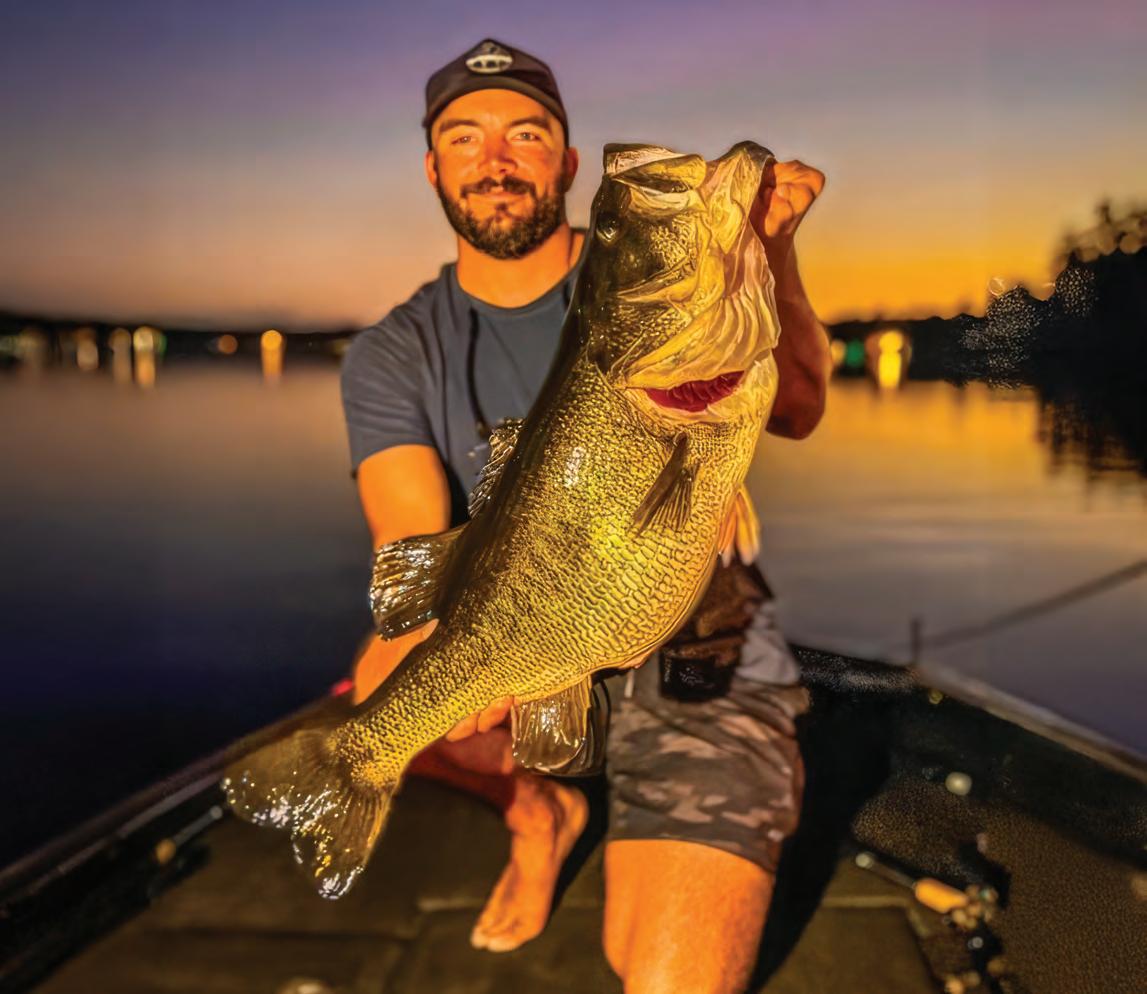
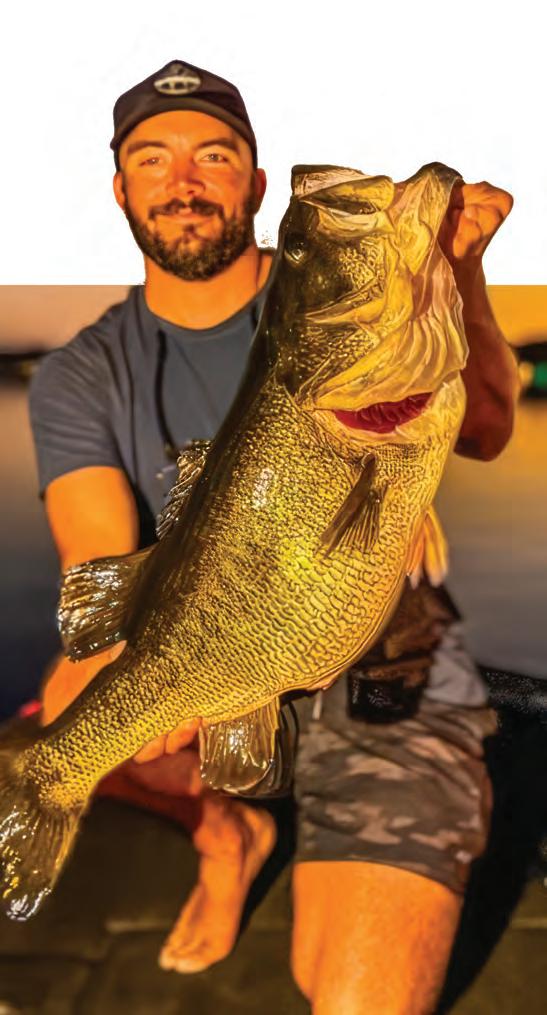
Tyler Woolcott is a professional tournament angler and guide. Check out his website at www.tylerwoolcottfishing.com.

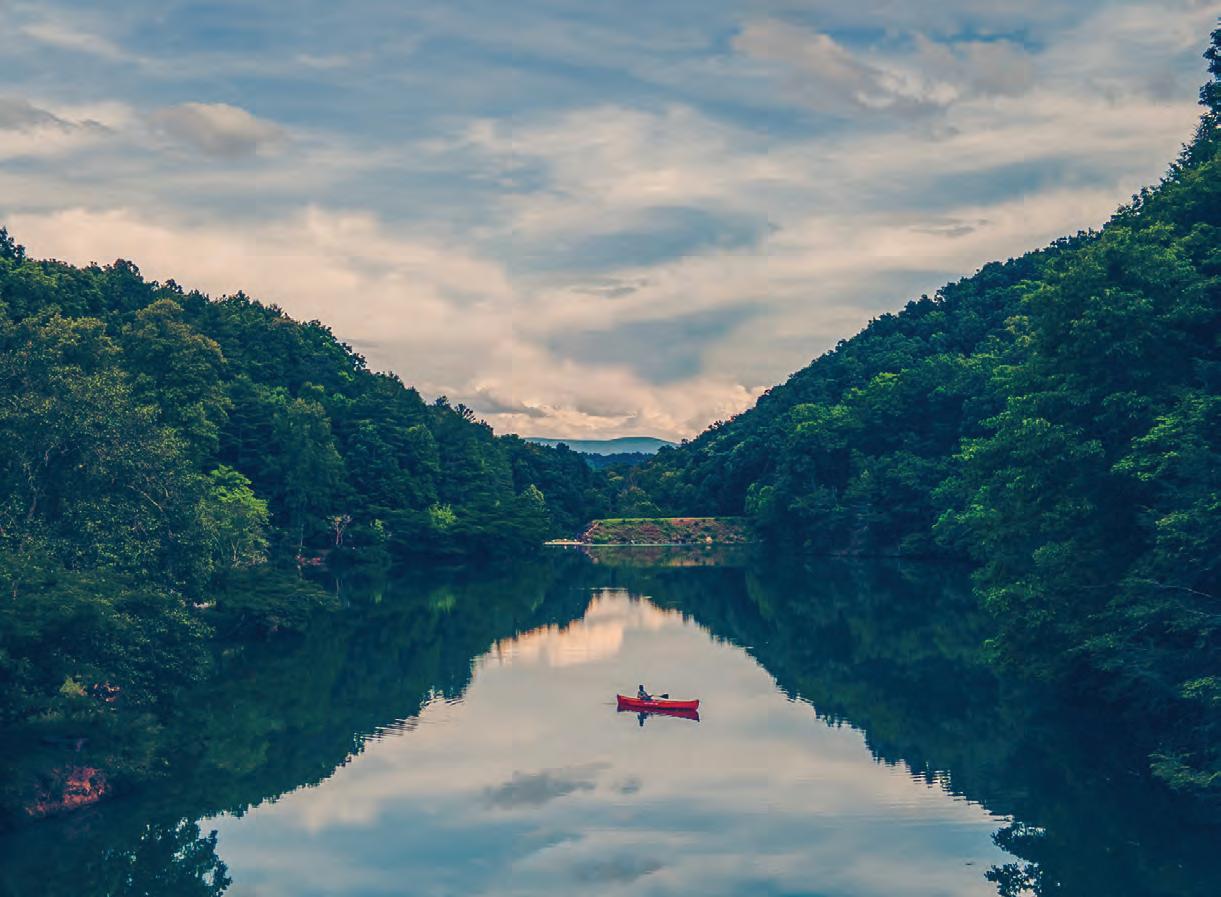



Welcome to Explore Bristol, where the charm of the Appalachian Mountains meets the vibrant culture of twin cities Bristol, Tennessee, and Bristol, Virginia. Whether you're a thrill-seeker, a history buff, or a nature enthusiast, Bristol has something for everyone.
HISTORIC DOWNTOWN
BRISTOL:
Stroll through the vibrant heart of Bristol, where friendly locals welcome visitors with open arms. Explore locally-owned restaurants, shops, live music venues, and arts and culture1. Don't miss the iconic Bristol sign, a symbol of the twin cities' unique heritage.
THE PINNACLE:

Shop, dine, and play at The Pinnacle, the region's premier lifestyle shopping destination. With national retailers, a variety of eateries, and unique entertainment options, it's a must-visit spot.
BRISTOL MOTOR SPEEDWAY:
Known as the "Last Great Colosseum," Bristol Motor Speedway is one of NASCAR's most popular race tracks. Experience the adrenaline rush of high-speed races in the world's fastest half-mile track.
BIRTHPLACE OF COUNTRY MUSIC MUSEUM:
Dive into Bristol's rich musical roots at the Birthplace of Country Music Museum. Learn about the 1927 Bristol Sessions, which gave birth to a new sound and sparked a passion for Americana roots music.
HARD ROCK HOTEL & CASINO BRISTOL:
Enjoy live music, world-class gaming, and exceptional cuisine at the all-new Hard Rock
Hotel & Casino Bristol. With multiple suite offerings, a large gaming facility, and a great selection of bars and restaurants, it's the ultimate entertainment destination.
THE GREAT OUTDOORS:
Explore the stunning scenery of South Holston Lake, Steele Creek Park, and Bristol Caverns. Enjoy fly fishing, hiking, and biking trails that showcase the natural beauty of the region.
LODGING:
Whether you're traveling for business, pleasure, or an outdoor adventure, Bristol offers a variety of lodging options. From national chain hotels to boutique accommodations, you'll find the perfect place to stay.
ExploreBristol.com provides all the information you need to plan your perfect trip, from accommodation options to special offers and events. Whether you're looking for a romantic getaway, a family holiday, or an epic solo adventure, Bristol has it all. Start exploring today and experience the best of this dynamic city! For

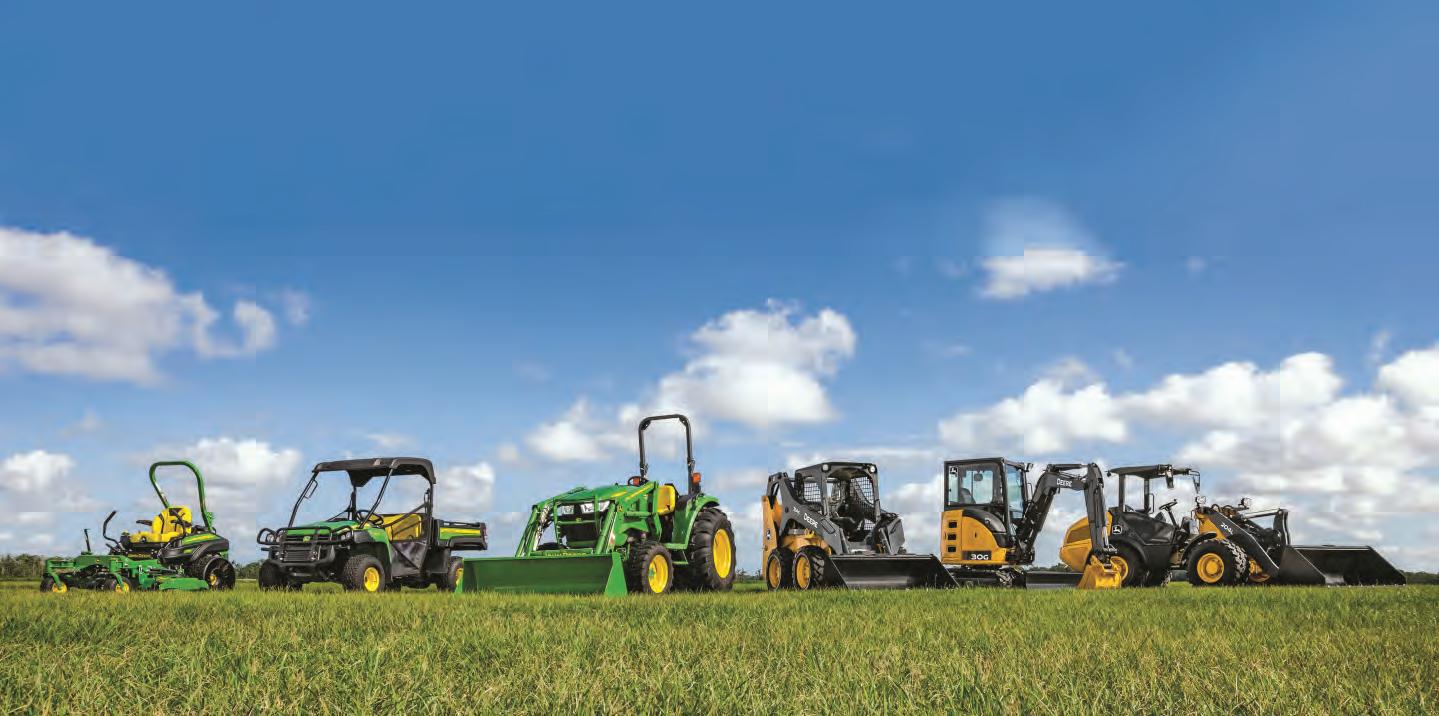






Once deployed off Destin-Fort Walton Beach, at nearly 1,000-feet long, the SS United States will be a home for a diverse range of marine life and attract divers and anglers from around the world. The purchase of the SS United States will continue the growth of Destin-Fort Walton Beach’s robust artificial reef program, the most active, and one of the largest vessel artificial reef collections in the United States. The County is actively working in close collaboration with the U.S. Coast Guard and other agencies to ensure this magnificent vessel is safely moved which requires multiple planning procedures, approvals, documentation and consideration of the weather and tides. Check back here for updates and follow the SS United States as she journeys from Philadelphia, PA to her final home.
Project Overview:
• The ship will undergo a thorough cleaning, be transported, and ultimately sunk.
• Okaloosa County will fund the creation of a land-based museum dedicated to the ship’s rich history.
• The total cost of the project is projected to exceed $10 million.
• The entire process is expected to take at least 18 months.
• The SS United States stands as a testament to American engineering prowess.
• It is the last remaining American-built ocean liner.
• The ship famously broke the transatlantic speed record on its maiden voyage in 1952.
• The artificial reef is anticipated to become a major diving destination, potentially boosting the local economy by millions.
Additional Details:
• The reef will be located approximately 20 miles south of the Destin-Fort Walton Beach area.
• The ship departed Philadelphia in February 2025, en route to Mobile, Alabama, for necessary preparations.
TO TRACK HER JOURNEY, CLICK HERE
In partnership with the SS United States Conservancy, a land-based museum and immersive experience is slated to be developed in DestinFort Walton Beach.
For more on the SS United States’ history, visit www.ssusc.org.
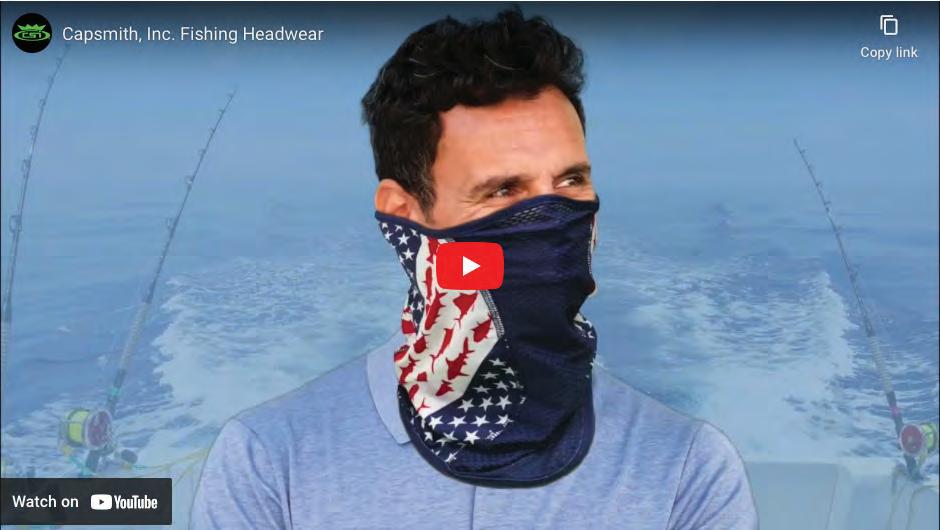


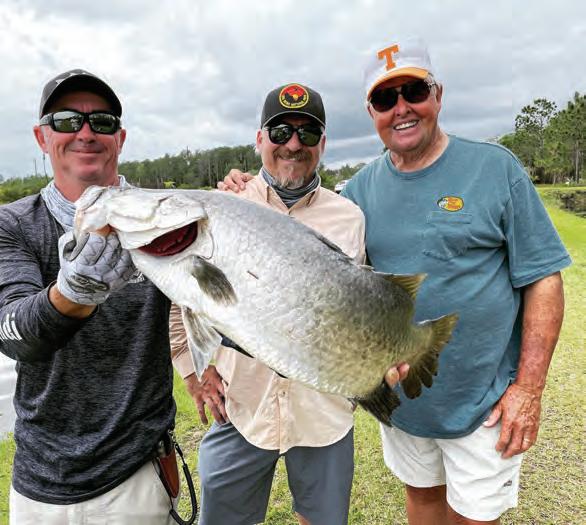

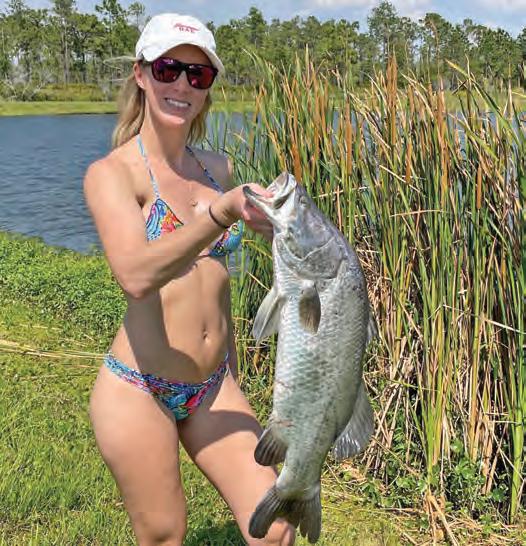


If you’re an avid angler seeking a one-of-a-kind fishing adventure, look no further than Osceola Outback Adventures. Located in Central Florida, just 45 minutes from the Orlando airport, Disney, and other attractions, this full-time guide service offers some of the Sunshine State’s most unique fishing experiences.
At Osceola Outback, you can embark on an unforgettable barramundi fishing expedition. What makes this experience truly special? Well, Osceola Outback is the first and only Barramundi guide service in North America. Native to Australia and weighing as much as 100 pounds, barramundi are hard-hitting, drag-screaming fighters that love to leap out of the water to display their power. The property is a working farm, ensuring that no angler goes home without hooking up multiple times. It’s a rare opportunity to catch these impressive fish!
Florida is a go-to state for bowfishing, thanks to its warm climate and abundant “non-game” fish. Osceola Outback offers both daytime and nighttime bowfishing trips. You’ll have the chance to shoot tilapia, gar, bowfin, and catfish in the state’s extensive network of lakes, ponds, and rivers.
Airboat Bass Fishing: Explore Uncharted Waters
For an adrenaline-pumping experience, try airboat bass

fishing. Osceola Outback’s custom-built airboats are equipped with 8-foot Blade Power-poles, trolling motors, and full walkaround fishing decks. With seating for three anglers and 500-horsepower motors, these boats can take you to places you’ve never explored before. It’s common for two anglers to land 60+ bass in a single 4-hour trip. Keep an eye out for alligators, wading birds, and birds of prey!
Known worldwide for huge stringers of largemouth bass, the Kissimmee Chain of Lakes offers fantastic fishing opportunities. Osceola Outback provides fully rigged bass boats, and their captains are United States Coast Guard certified and licensed. You can choose between fishing with artificial lures or locally caught live wild shiners.
Here’s something truly unique: Osceola Outback is the only place in the world where anglers can land an International Inshore Slam. This prestigious achievement consists of catching barramundi, peacock bass, and largemouth bass all in one location. With barramundi native to Australia and weighing up to 100 pounds, this is an angler’s dream come true.
Whether you’re a seasoned angler or a first-timer, Osceola Outback Adventures promises unforgettable fishing experiences. So grab your gear, cast your line, and get ready for an adventure like no other!
The International Game Fish Association (IGFA) tracks record fish catches around the globe. Their world record database is a great source to see some of the fish anglers are catching around the world. Here are a handful of catches recently approved for the record books. To see all newly approved IGFA records, visit igfa.org.
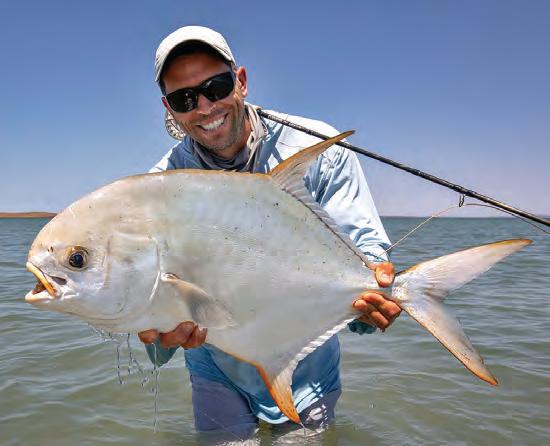


On October 27, 2024, Craig Williams was fishing the flats of Dampier in Western Australia, when he landed this impressive 14-pound, 10-ounce snubnose pompano. With this fish, Craig has set the IGFA Men’s 16 lb. Tippet Class World Record. Craig was able to fool this record pompano on a crab fly. After recording the weight on his certified scale, he was able to release the fish safely.

Captain John Cooney achieved the IGFA All-Tackle Length Fly World Record for albacore tuna aboard the “Shake N Bake” out of Ilwaco, Washington. His 25.2-inch albacore attacked his bull trout imitation fly, and John landed the fish after a seven-minute fight. Using his Official IGFA Measuring Device, he recorded the length before safely releasing the fish.
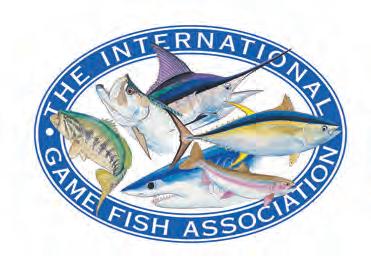

Agnieszka Szelag was fishing the Rio Ebro in Spain on September 6, 2024, when she landed this impressive 130-pound, 15-ounce wels. With this fish, Agnieszka has set the IGFA Women’s 50 lb. Line Class World Record for the species. She was able to land this record wels after a 70-minute fight; after recording the weight on her certified scale, she was able to release the fish safely.

On June 1, 2024, Robert Kowalski was fishing off Miami, Florida aboard the Miss Britt when he landed this massive 50-pound, 1-ounce blackfin tuna. The record blackfin struck a live bait off a kite and was boated after a 20-minute fight. Robert then returned to Grove Harbor Marina in Coconut Grove for an official weight on a certified scale. With this fish, Robert has set the IGFA All-Tackle World Record for the species.
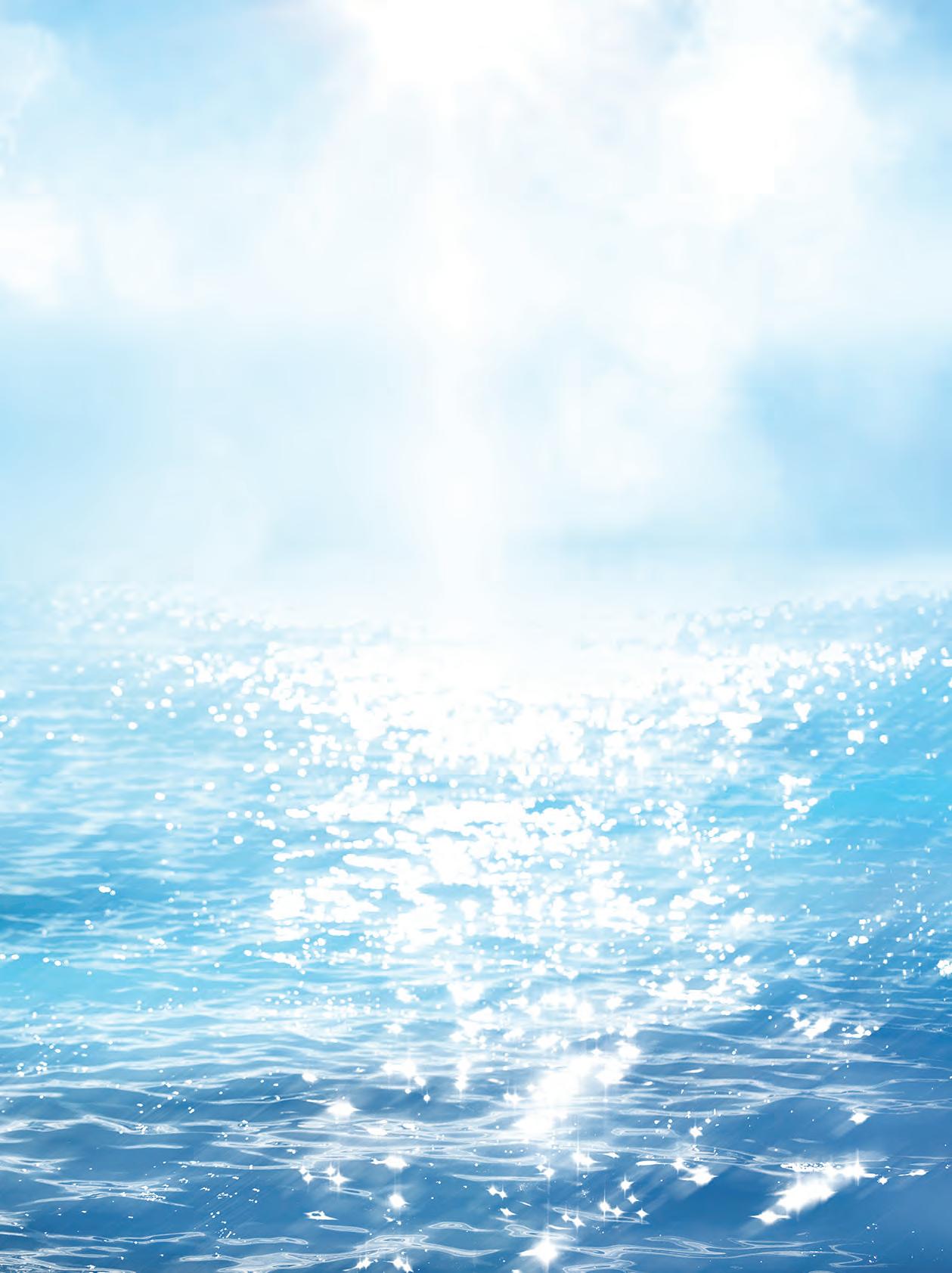







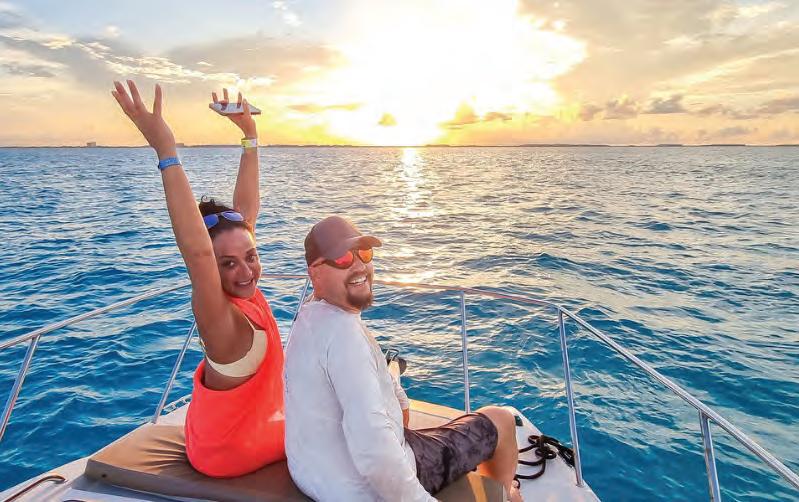
If you love the outdoors and dream of being in business for yourself—but not by yourself, now is the perfect time to make a change and choose a Coastal Angler or The Angler Magazine Franchise. We have freshwater and saltwater territories available throughout the country and abroad. Ask one of our specialists about franchise availability in your area.






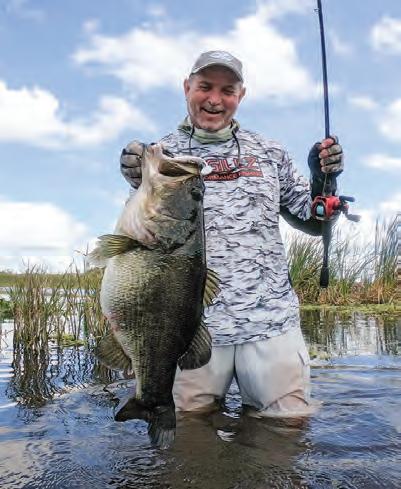


With a combined national readership of over a million per month and distribution to over 11,000 businesses in four regions, Coastal Angler Magazine and The Angler Magazine are the preferred resources for anglers and outdoor enthusiasts. Our brand is well known throughout the fishing world, and our free monthly magazines are recognized as well-designed, thoughtful publications that provide newsworthy and entertaining information pertinent to the marine and fishing industries.
An exceptionally rewarding and fulfilling business opportunity, as a co-publisher of your area’s Coastal Angler or The Angler Magazine, you’ll enjoy the benefits of controlling your own time and future. Our proven franchise publishing system enables individuals with no prior publishing experience to publish a credible and profitable localized version of our award winning magazine. We provide complete training and on-going support to ensure your success.


